Contact us now!


Client: Obmin.Finance. Imagine this: a bold startup that strives to become not just another player, but a single hub for the entire currency and crypto market, where users can see offers from all exchangers at once. This ambitious project was supposed to be a personal compass and a treasure map in one magic box!
Table of Contents
An invaluable tool for wise investors planning long-term expeditions to profit islands, for desperate traders catching every financial wave, and for all earthlings who simply need to exchange their blood money for shiny dollars or bitcoins at a rate that warms not only their souls but also their wallets! First, Ukraine and the “near abroad” (CIS), and then, if things go well, you can take a swing at the global market. Classic.
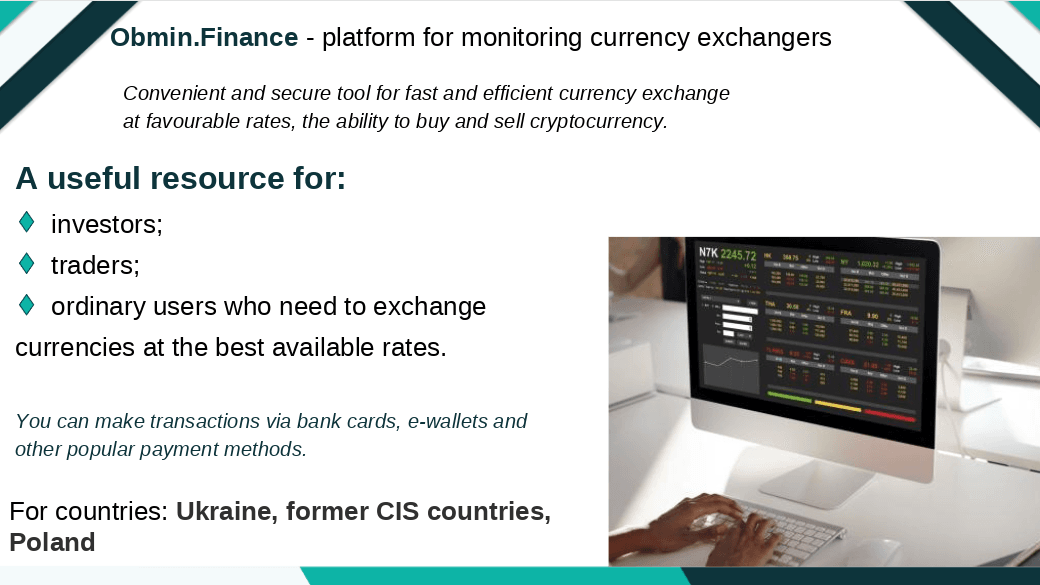

The challenge for JobStudio: we were tasked with more than just “preparing a website for promotion.” No, it’s more serious than that: a deep dive into the technical jungle, SEO alchemy, content that hits the mark, and, of course, inexhaustible reserves of caffeine and black humor to keep the team’s morale up.
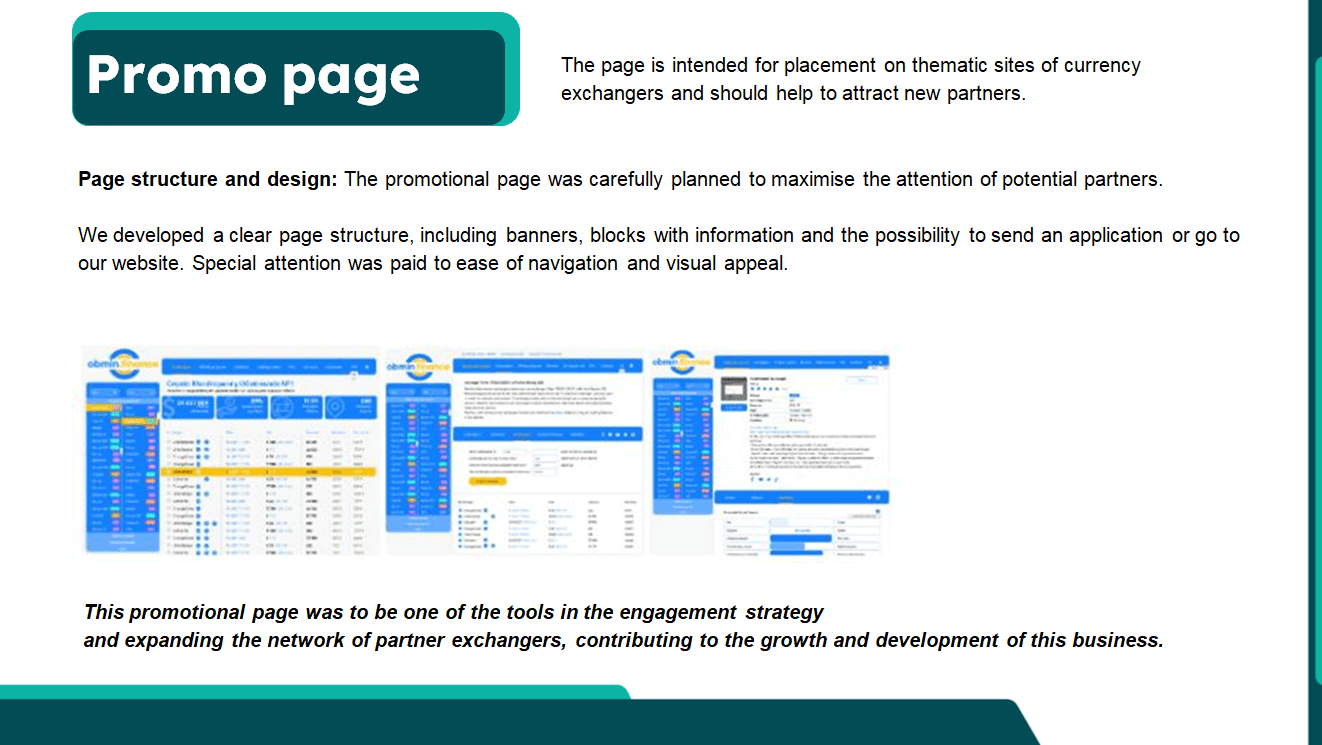

Reality: as always, it’s harsh. The deadlines are as tight as the budget of a young project. The financial and crypto market is a nervous substance that jumps up and down more often than a teenager’s mood. Plus, there were technical “features” that popped up here and there. Below is a detailed account of how we tried to keep this ship afloat before it was even launched.
Context: why did Obmin.Finance need our in-depth expertise (or why didn’t they hire someone cheaper)?
It’s easier to imagine the task: trying to squeeze onto a dance floor where monsters like BestChange have been steadily trampling the ground for a long time. These are not just websites – they are entire ecosystems. To have any chance at all, Obmin.Finance needed a comprehensive approach that went far beyond the standard one.
We had toperform an engineering feat: that is, organically combine development, SEO strategy, and content creation. The problem was that the site was being written “live,” and the development team was generating code while we were already planning how it would be indexed and ranked. It was crucial that the left hand (development) not only knew what the right hand (SEO/content) was doing, but that they acted in sync without interfering with each other to create a future masterpiece (or at least a working product).
Instantly become “know-it-alls” in the CIS: it meant more than just reading a couple of articles. We had to dive into the specifics of 7 different markets. We conducted an extensive SEO analysis to identify the main competitors of exchange aggregators in Ukraine, Kazakhstan, Russia, Azerbaijan, Uzbekistan, Georgia, and Armenia. This in-depth audit, which went far beyond simple keyword research, included an analysis of domain metrics, traffic sources, internal and external optimization strategies, content quality, website architecture, and unique features. The results of this comprehensive research are the foundation for developing an effective and competitive SEO strategy. Add in language barriers and cultural differences and it’s a fascinating quest for analysts.
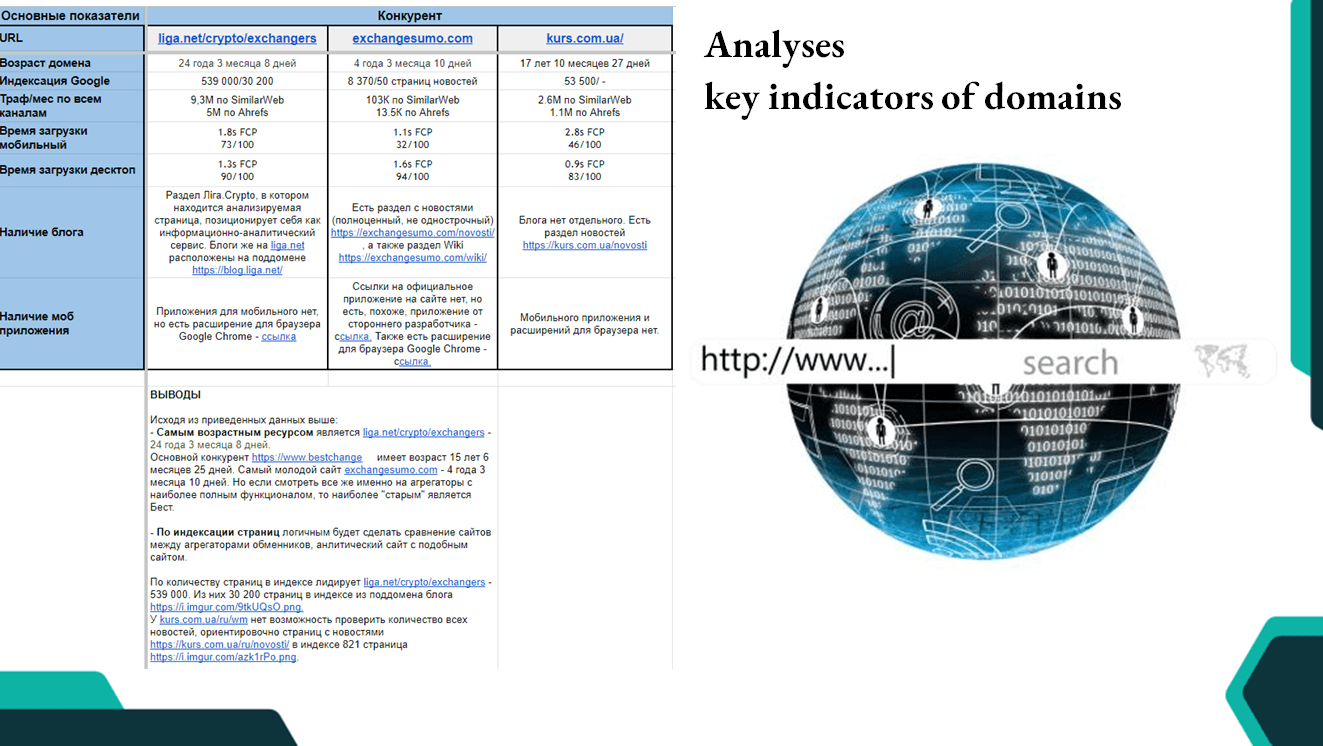

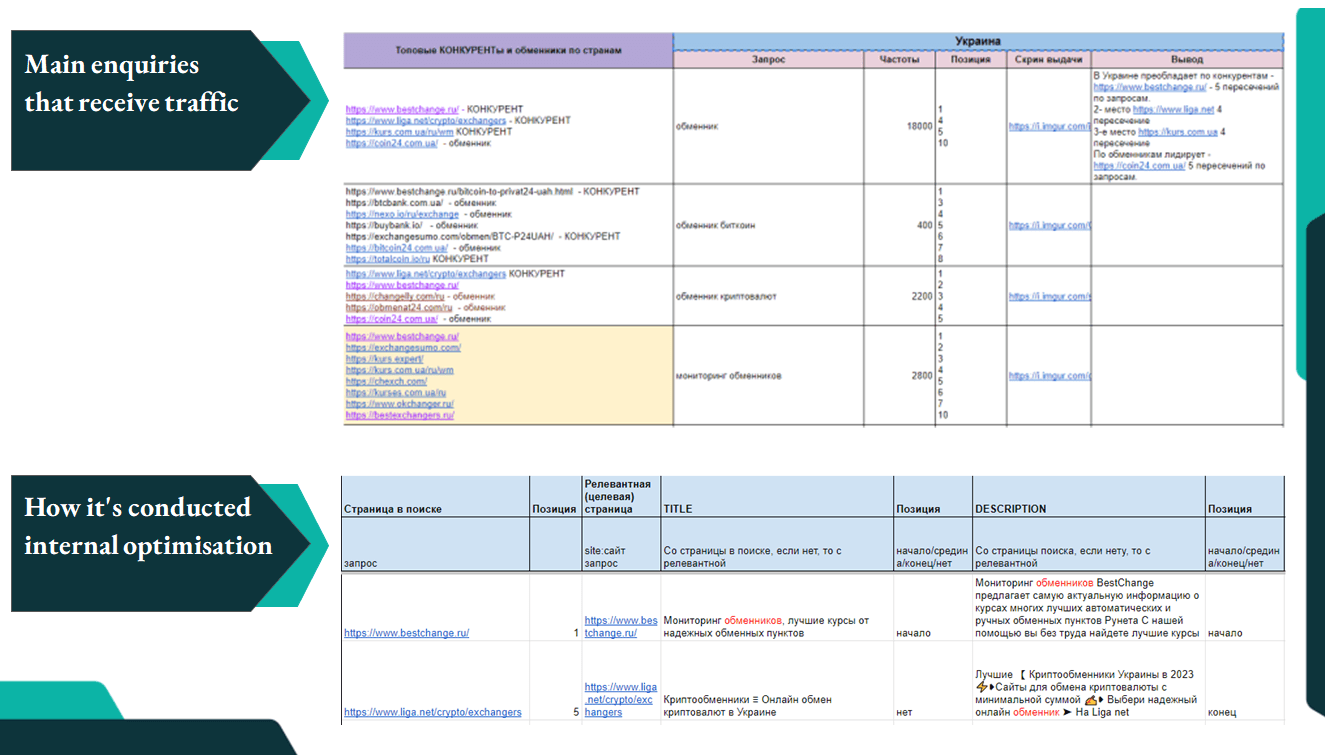

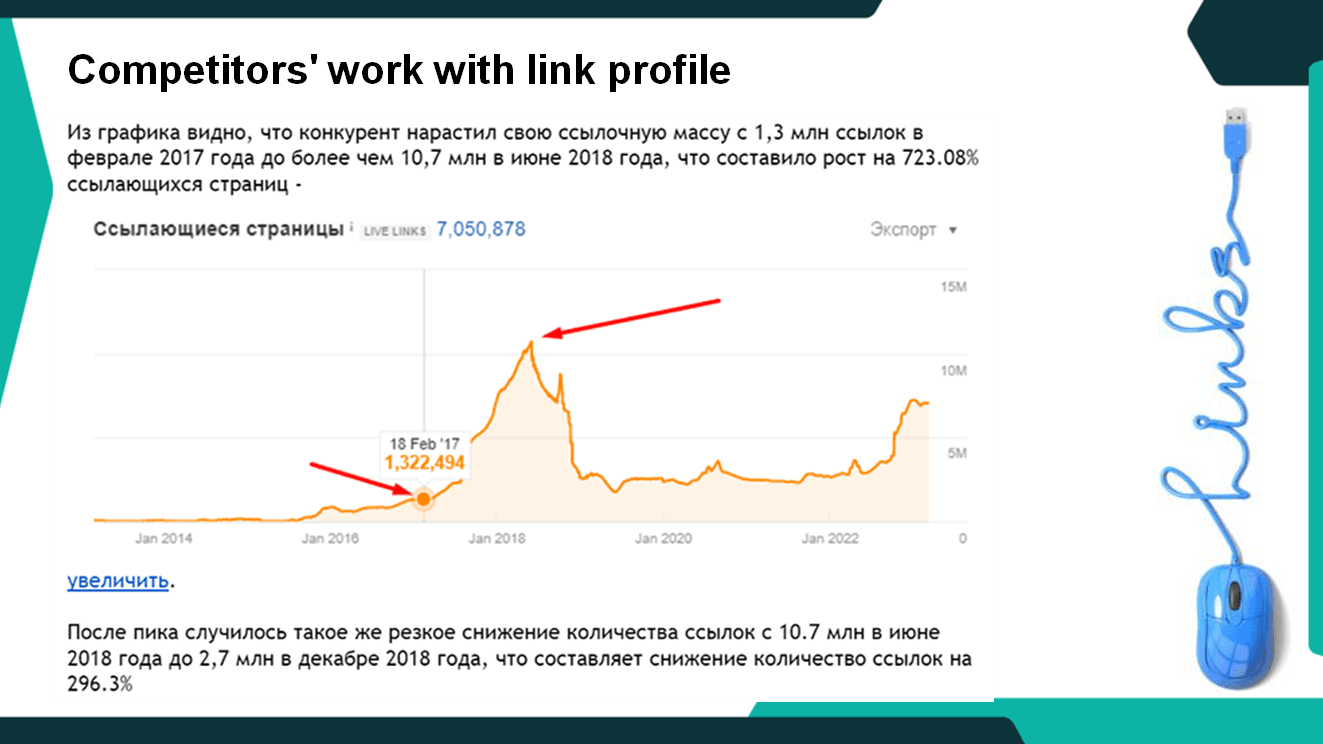

To develop a high-performance solution capable of consistently processing and analyzing data from 28,000+ currency pairs for SEO purposes, including identifying search intents, optimizing landing pages, and scaling content strategies without losing efficiency. And this is not an exaggeration. From super-popular combinations like BTC → UAH to completely exotic pairs that we only learned about in the course of our work. Each pair is a potential entry point for the user, and the system had to process, display, and optimize them correctly for search queries.
JobStudio entered the game when developers were already banging away at their keyboards. Our mission was to become those “gray cardinals”. Our work was less visible than creating a colorful interface, but, in our opinion, no less important. It’s like laying communications in a house – no one sees it, but you can’t do without them.
Objectives: why was classic SEO not enough this time (hint: because the task was much bigger)?
It was impossible to simply “optimize for the keys” here. It was necessary to think in terms of product categories, not individual sites.


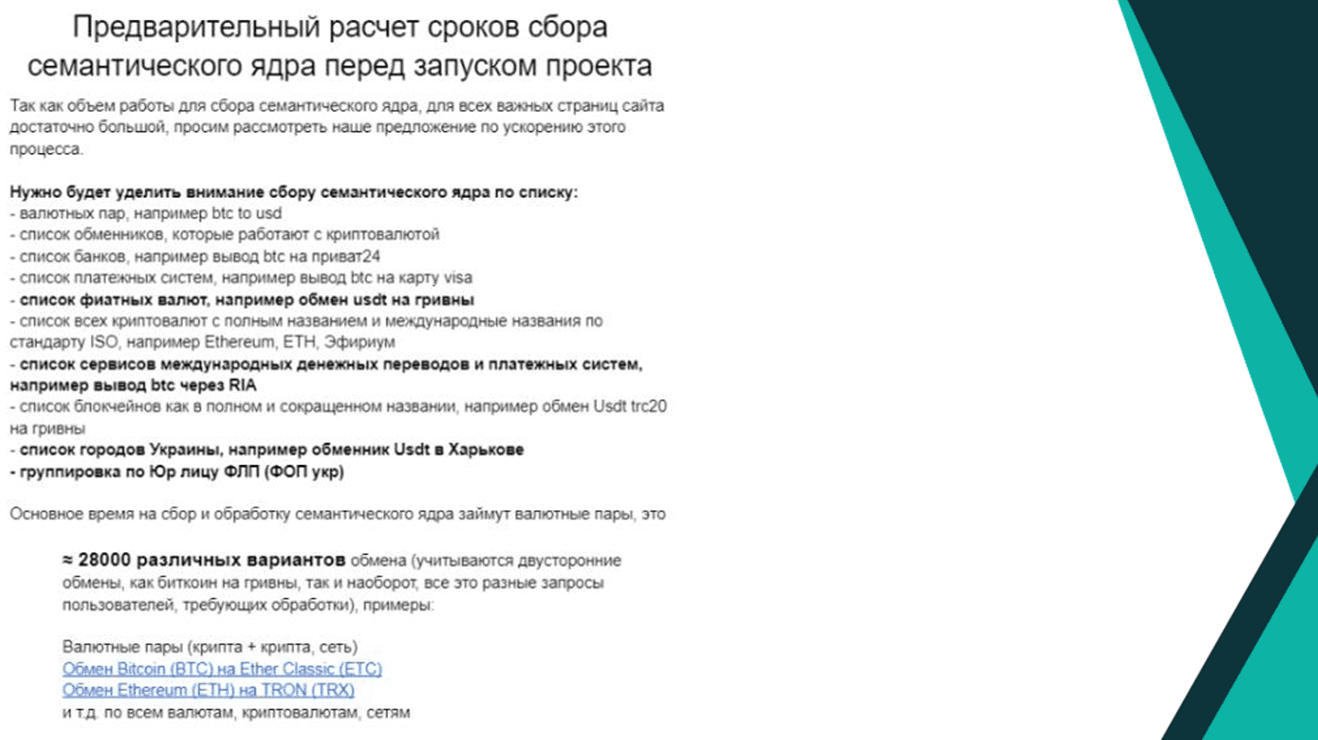

We’ve outlined the vector of our brave mission, and now it’s time to dive into the details of each item!
Since the site didn’t exist yet, a classic SEO audit was impossible. So we developed our own approach. It was a comprehensive document that covered all the critical aspects of preparing a website that did not yet exist to meet search engines and users:
Technical “joys”: download speed (so that the user does not run away without waiting for the courses), correct processing of data migration (if planned), correct multilingualism settings (hreflang tags are our everything!), redirect logic, code cleanliness.
Content requirements: what should be the structure of the website for the convenience of users and robots? How to group thousands of pages of currency pairs? How to categorize the semantic core so as not to drown in the keys and create relevant pages? What types of content are needed (reviews, guides, news)?
Competitor analysis: who is already on the Olympus in the target CIS countries? What are their strengths and weaknesses? What website structure do they use? What kind of content do they generate? We analyzed the top 10 players to understand the rules of the game and find opportunities for Obmin.Finance.


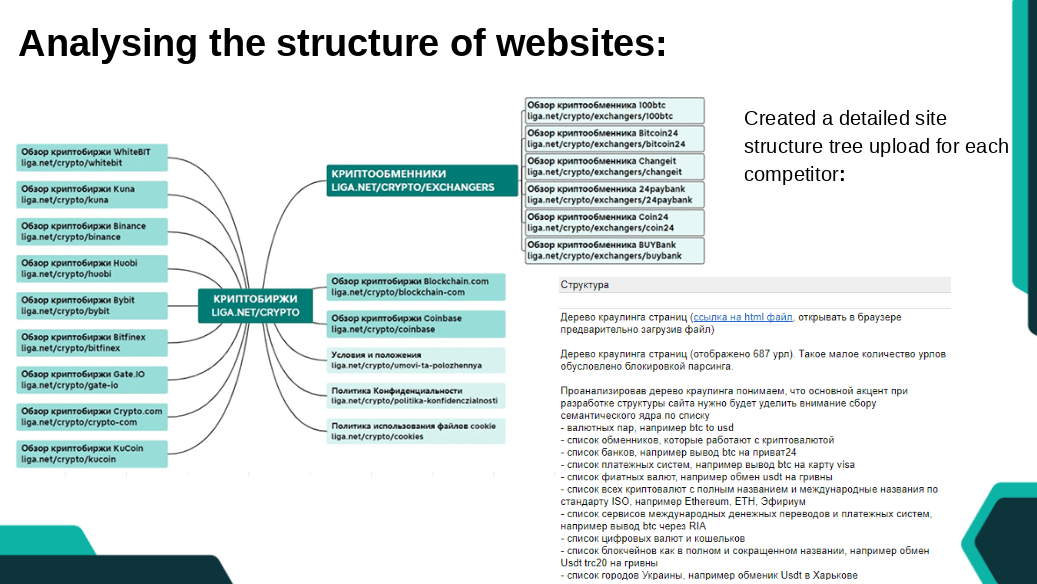

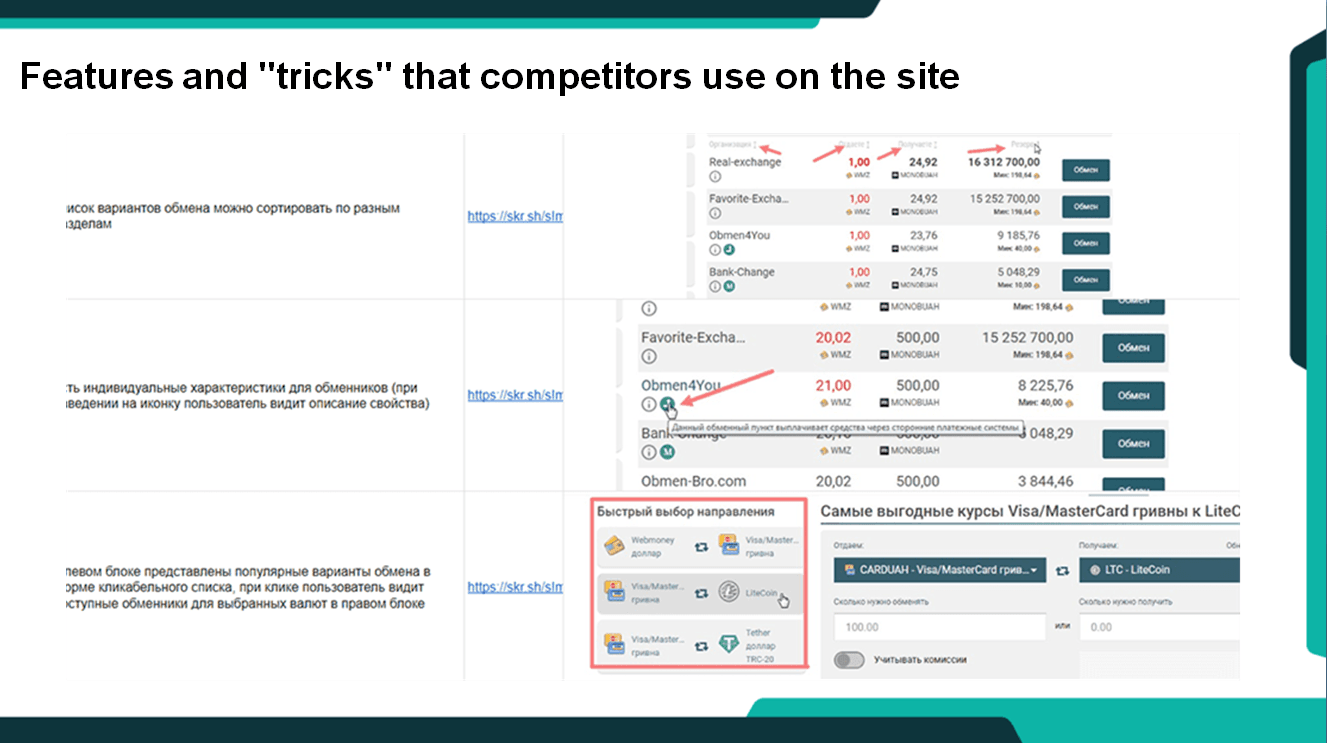

Technical kitchen: how we “prepared the patient” for a meeting with Google
The platform was developed on the Laravel framework. We implemented the terms of reference (ToR) for the integration of search engine optimization (SEO) tools into the relevant sections of the site’s administrative panel to improve the management of SEO parameters.
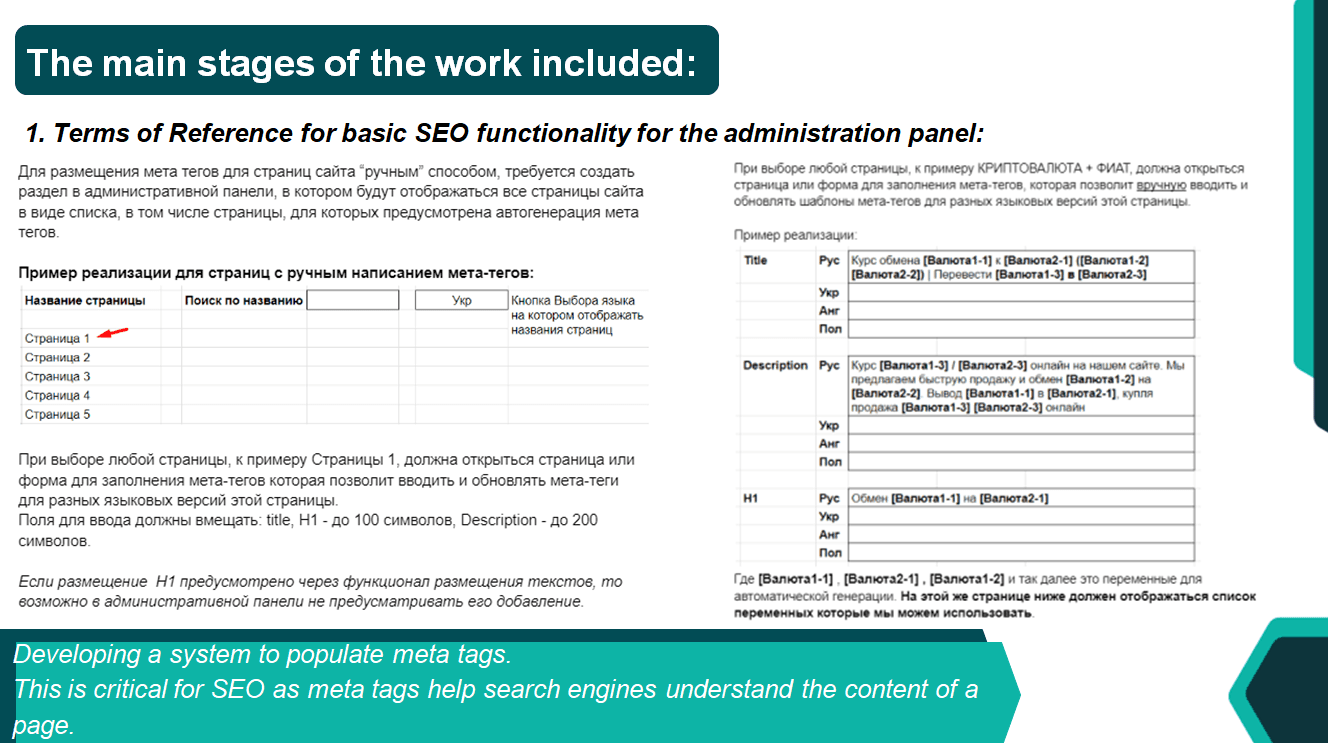

Avoiding cannibalization and duplication: It was critical to explain that pages like “BTC → UAH” and “UAH → BTC” are different entities from the user’s and search engines’ point of view, and they should not compete with each other for the same queries. Setting up filter logic and URL generation.
Canonical URLs for each language version: so that Google clearly understands which page is the main one for a particular language/region, especially if there is similar content.


Automation of sitemap.xml generation and updating: for a website with thousands of pages that are potentially added and changed, manual management of the sitemap is a road to nowhere. We needed integration with the admin panel for automatic updates.
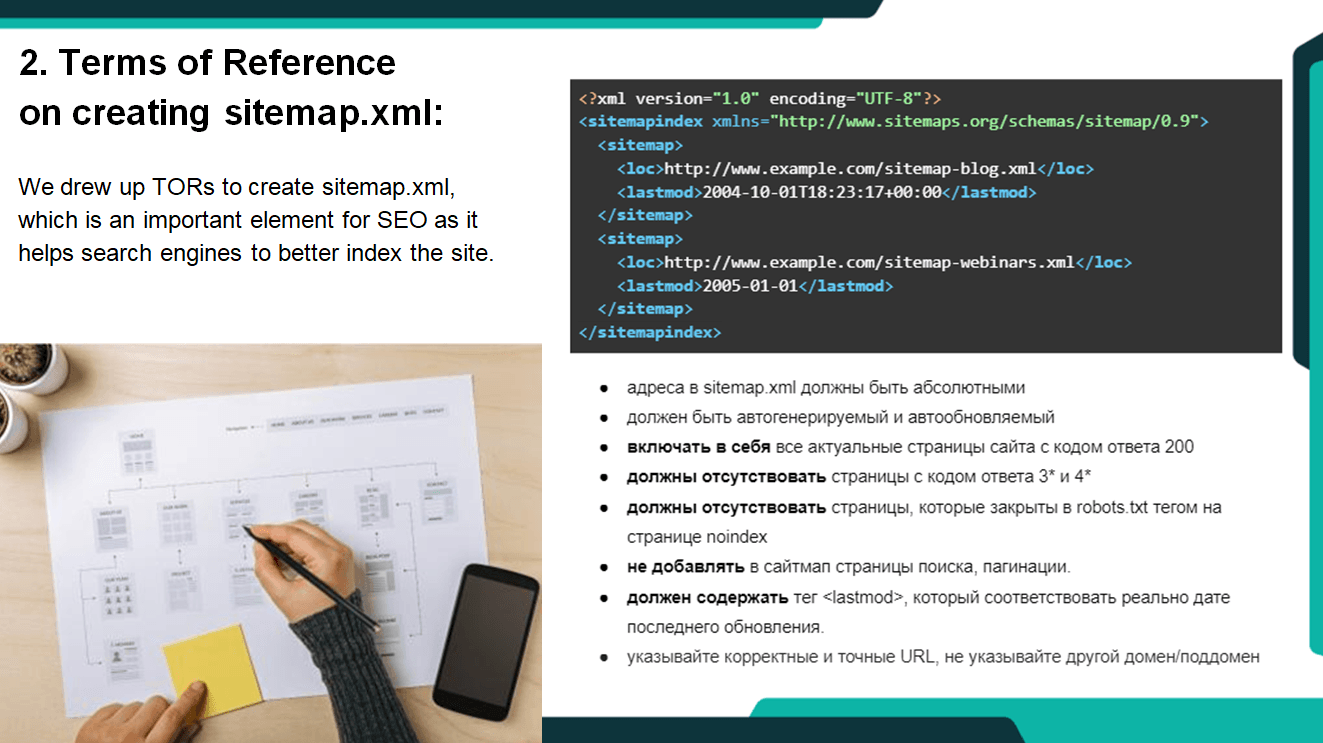

work with images: implementation of the WebP format as a standard, automatic compression without loss of quality, weight limit (approximately up to 100 KB).
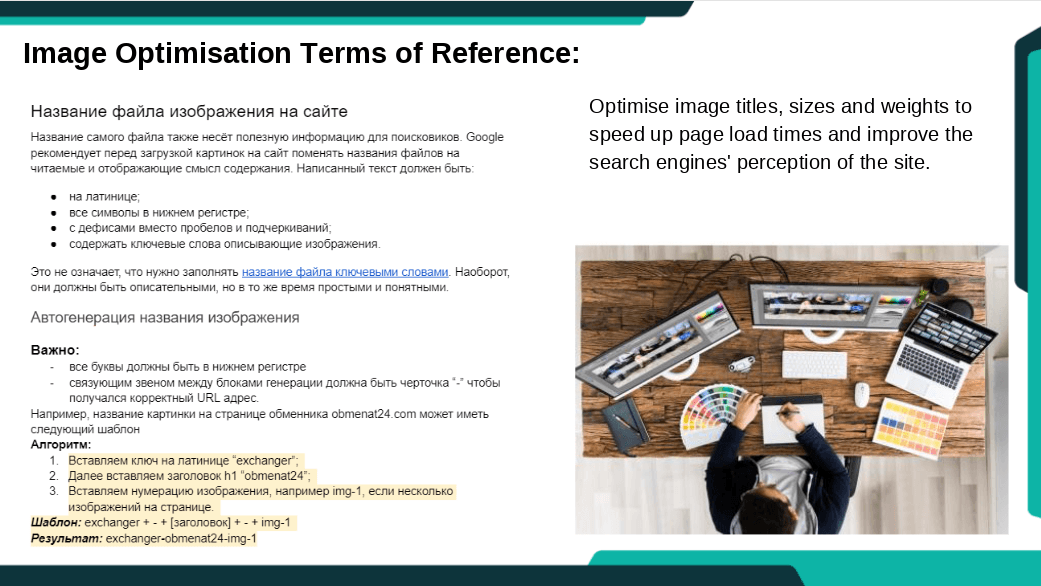

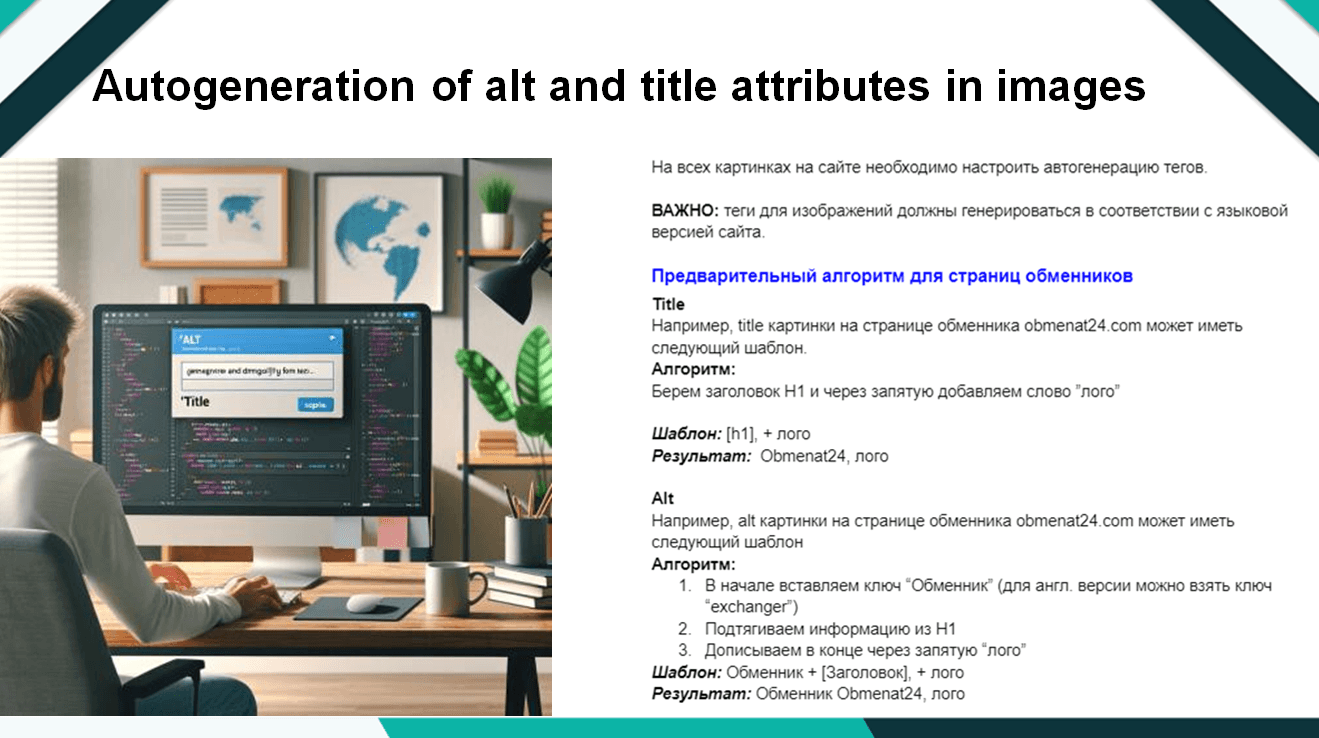



Caching at all levels: from caching data from the database for dynamic blocks with courses to browser caching of static resources. Optimization of database queries.
other techniques: CSS/JS minification, server optimization, CDN usage (in the future).
Implementation of hreflang tags: a clear indication for search engines of the availability of alternative language versions for each page, targeting 7 target countries.
setting up automatic redirects by geolocation: a user from Ukraine is redirected to the Ukrainian version by default, and from Kazakhstan to the Russian (or other relevant) version. This improves usability and behavioral factors.
Implementation of extended micro-markup (Schema.org): at least 10+ types of markup for different entities:
This helps Google to better understand the content and create attractive snippets in the search results.
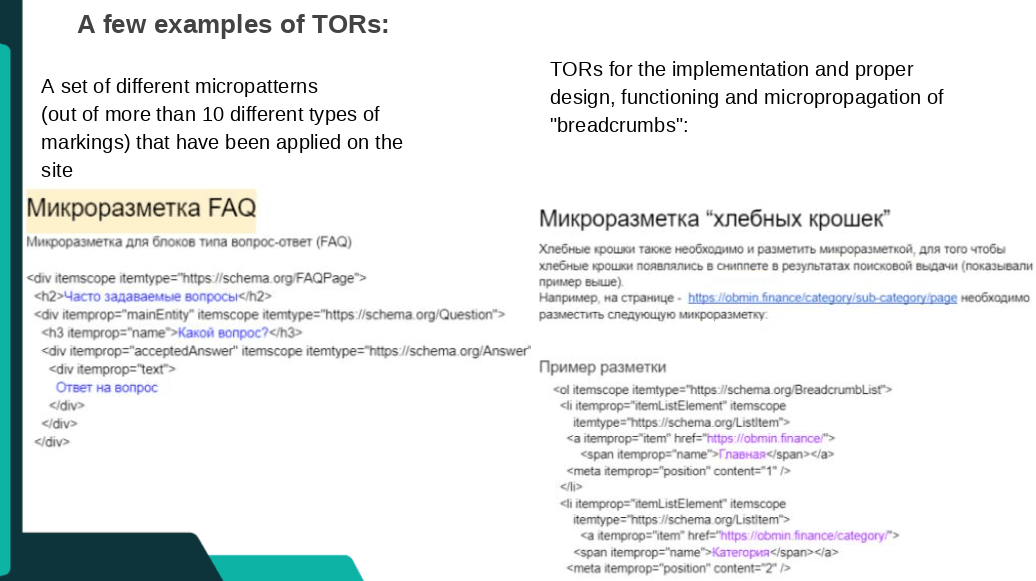

Development of a meta tag generation system: creation of flexible templates for automatic generation of unique and relevant “title” and “description” for 60+ different types of pages (home, categories, currency pair pages, blog articles, partner pages, etc.)
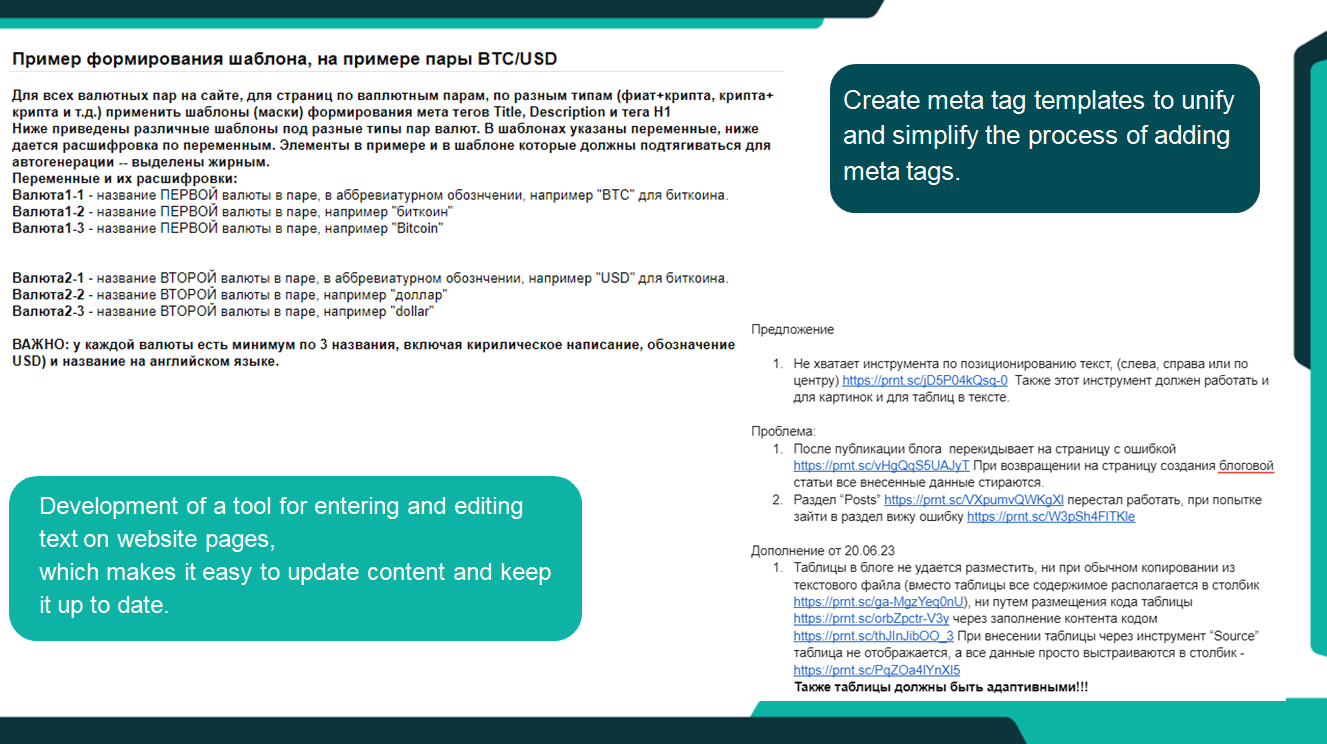

An example of a template for a pair: “Current rate of [Currency 1] to [Currency 2] today | Best exchangers on Obmin.Finance”.
This saves you from having to enter thousands of tags manually.


Setting up a test environment and quality control: Having a test domain that is as close to the live domain as possible to check all SEO settings, correct indexing, and track errors (especially 404) before the official launch.
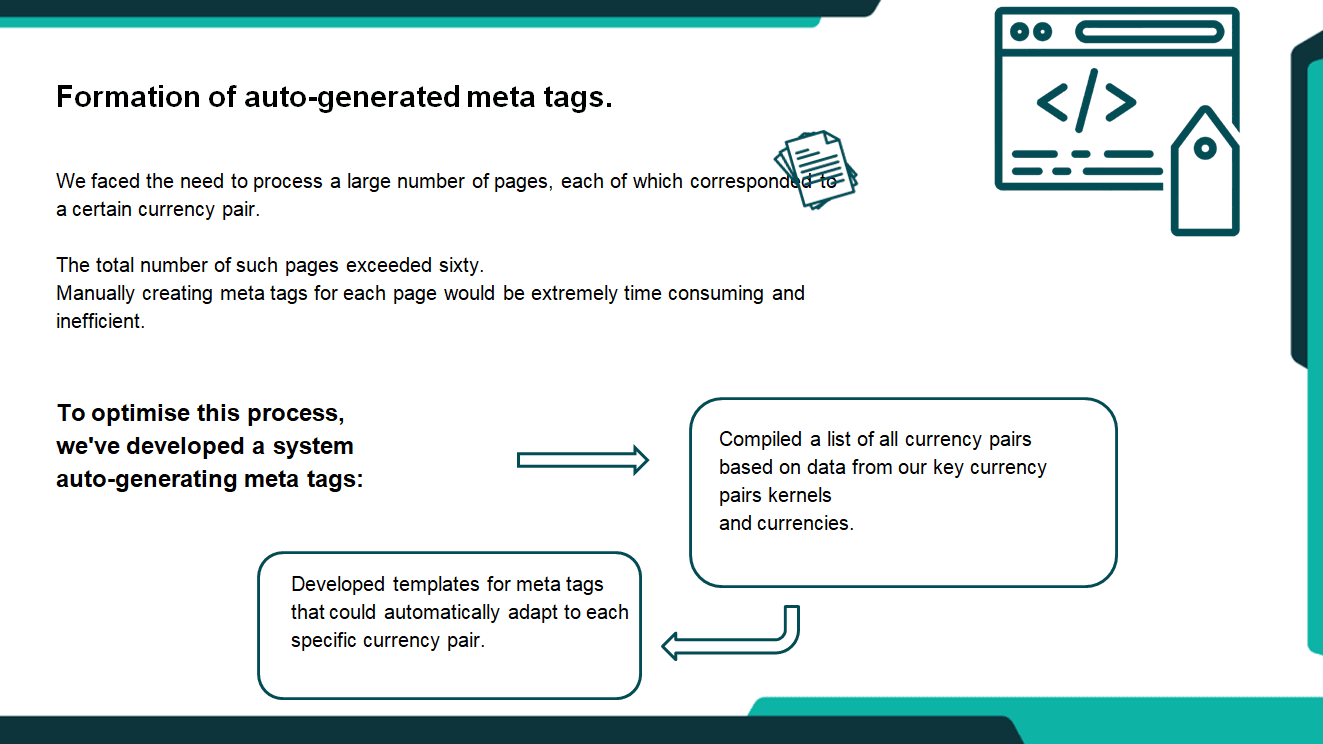

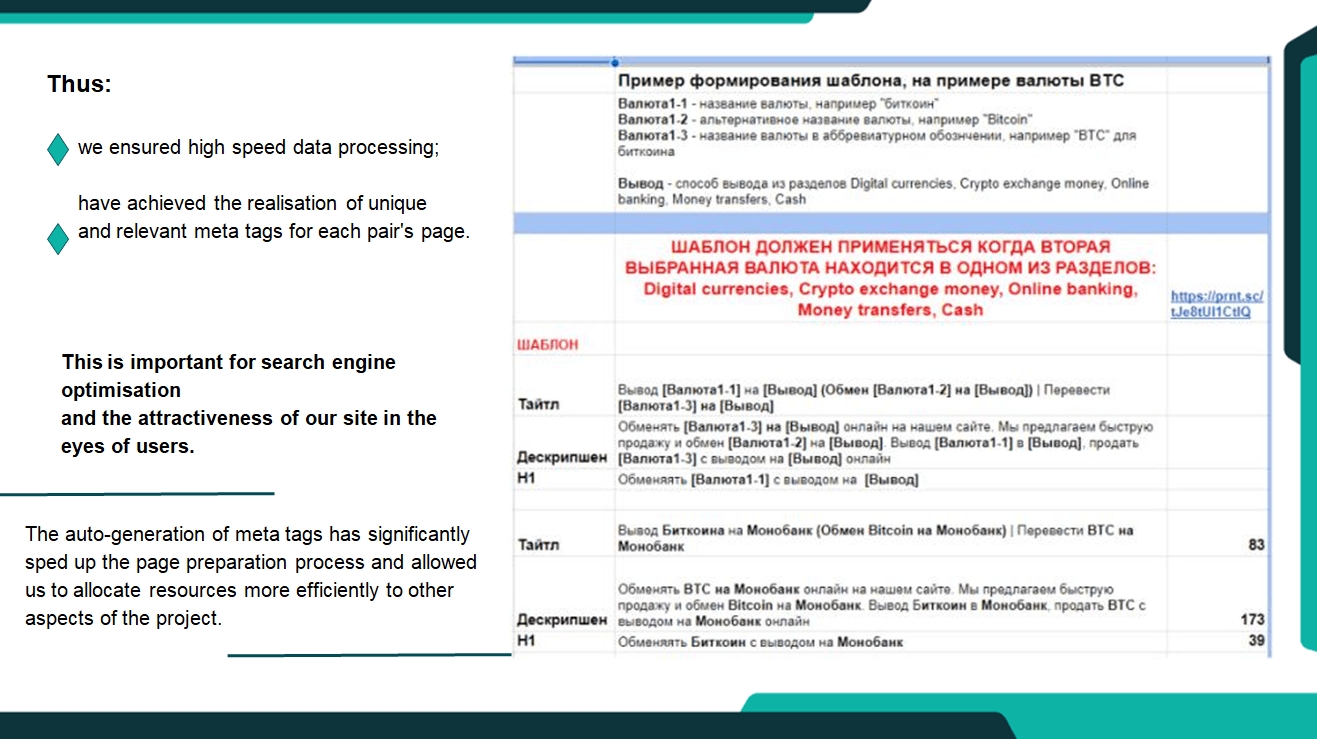

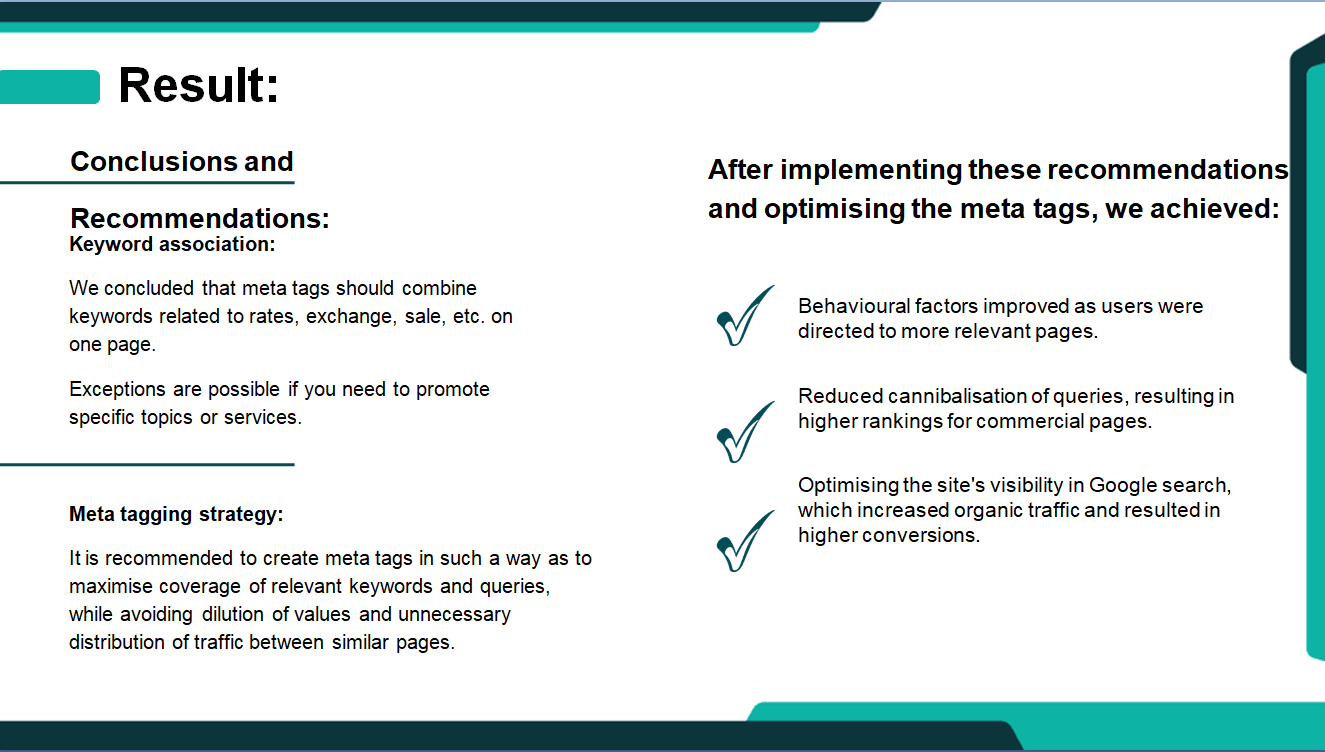

The speed of response to external events was also important. A classic example is the collapse of the LUNA token. We had to quickly develop a mechanism to temporarily exclude problematic assets from the monitoring pages so as not to mislead users and damage the platform’s reputation.
BestChange – the site we’ve been watching
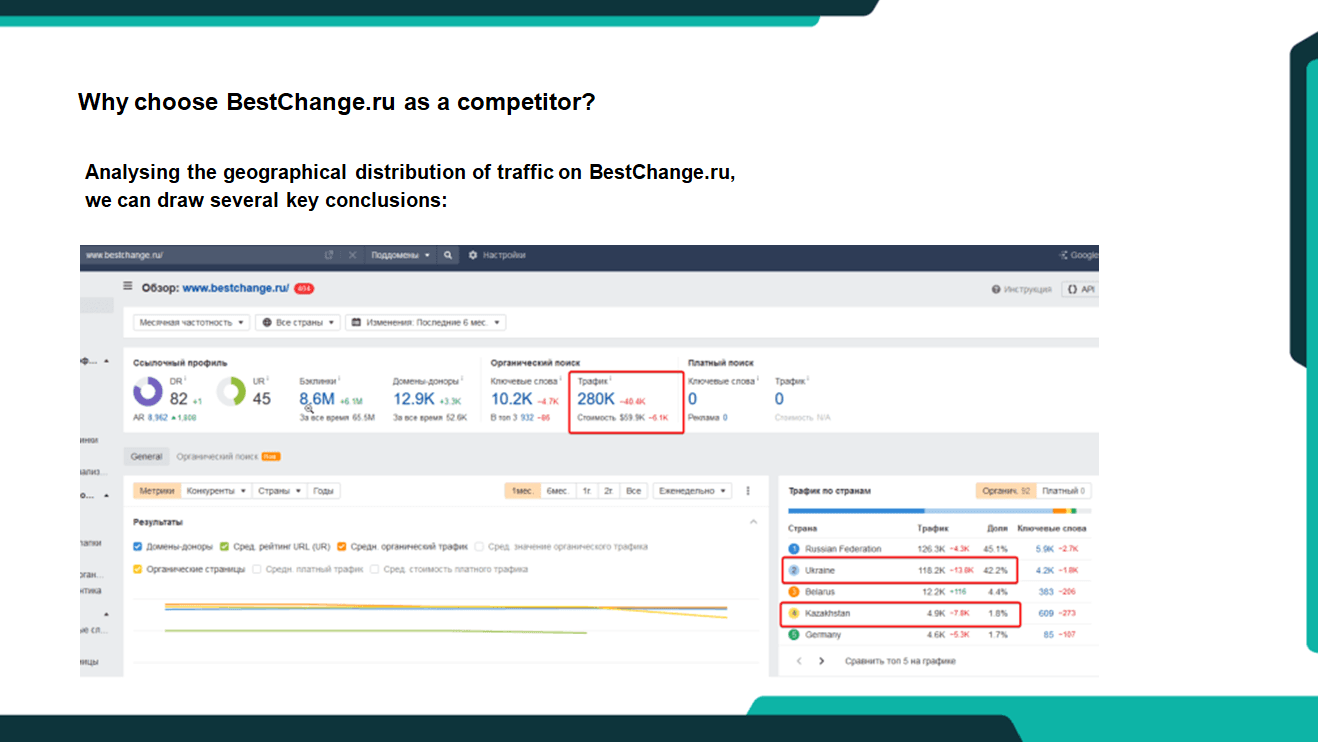

Traffic: Impressive – about 280,000 visits per month (according to analytics at the time). However, a closer look revealed that 42.2% of this traffic came from Ukraine, the main target market for Obmin.Finance’s launch. This meant that there was potential for growth.
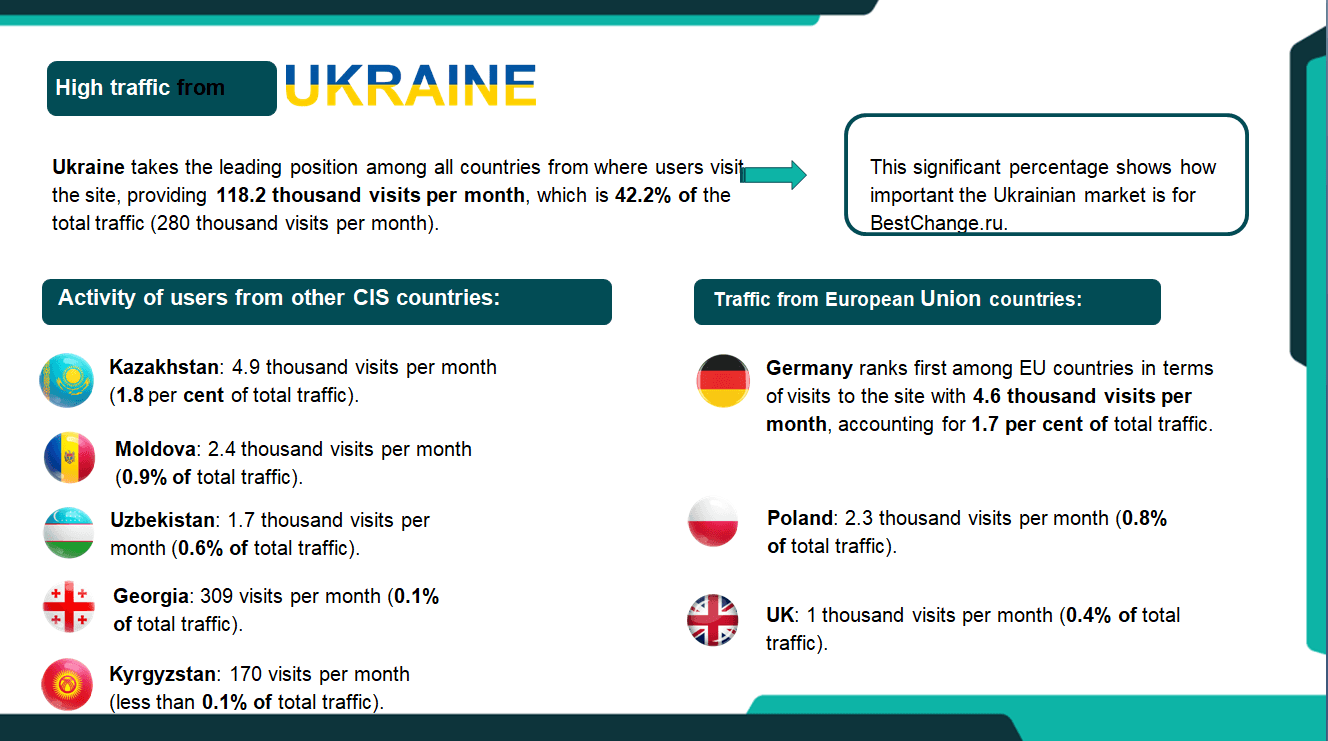

Geography: An interesting discovery was the noticeable traffic from Europe, in particular from Germany (4,600 visits/month) and Poland (2,300 visits/month). This became a valuable insight for Obmin.Finance regarding potential areas of development in the future.
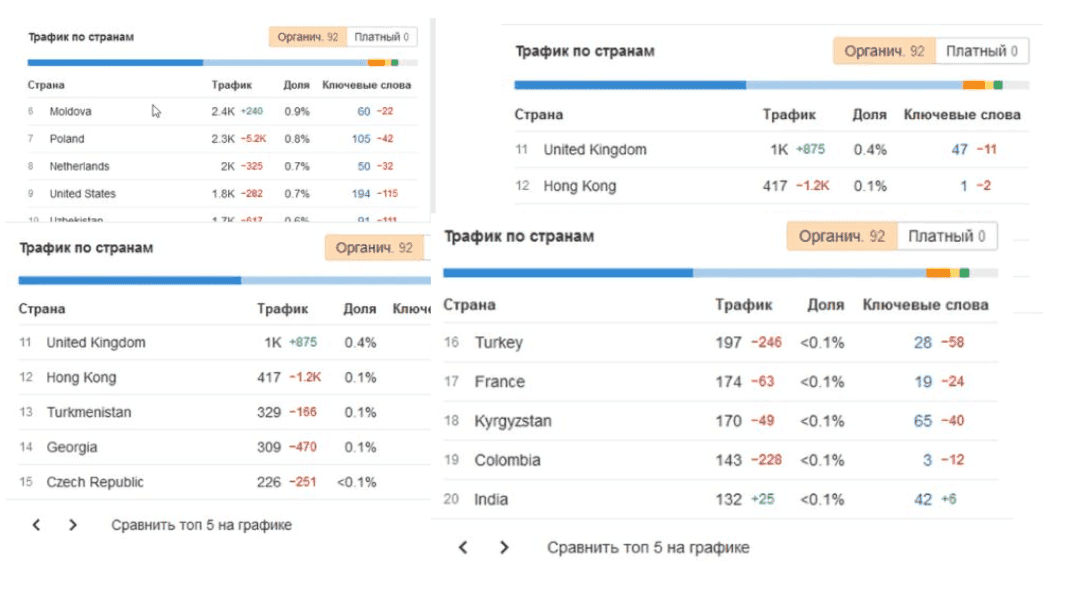

Weaknesses (and everyone has them):
Loading speed: The measurements showed not the best results – about 3.5 seconds to fully load the desktop version. In a world where every millisecond counts, this gave Obmin.Finance a chance to stand out through better optimization.
Multilingualism: Although the main languages were present, localization for smaller but potentially interesting CIS markets (e.g. Georgia, Armenia) was either absent or not formally implemented. This is another opportunity for Obmin.Finance to offer a better user experience.
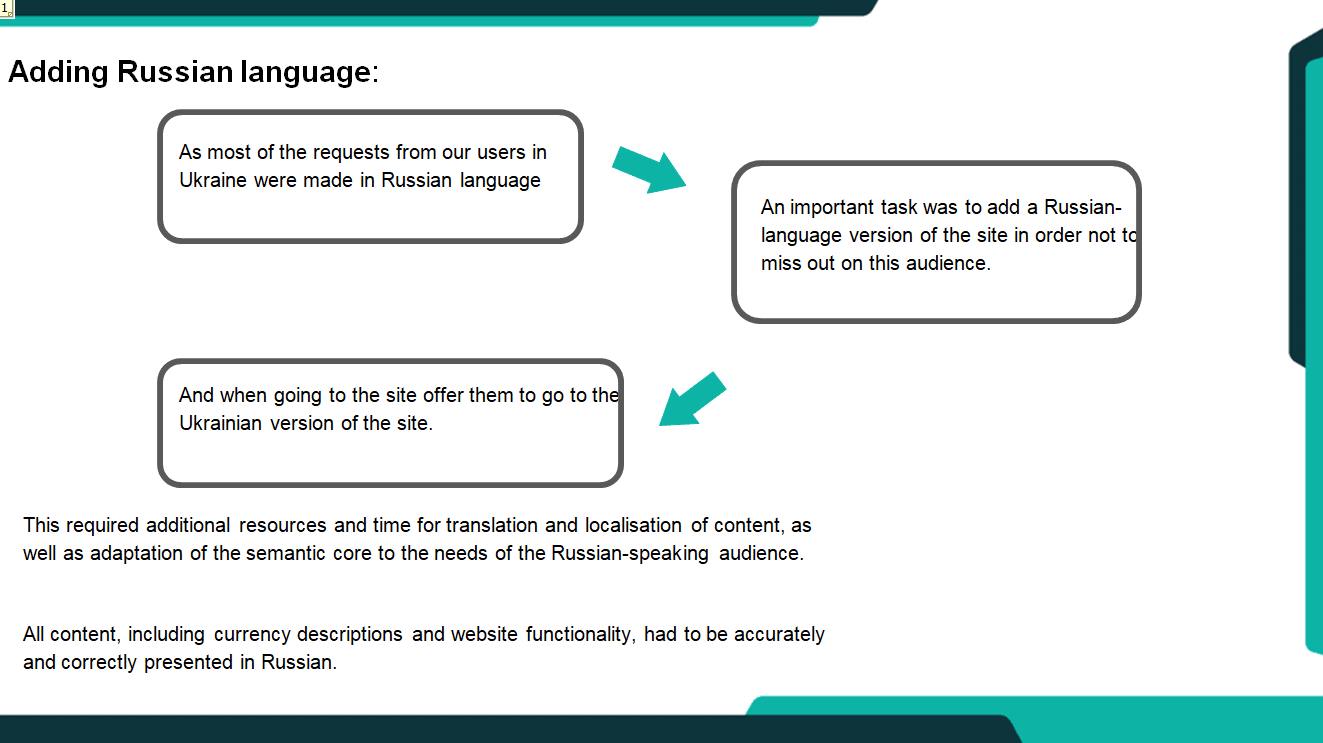

Website structure: we did not reinvent the wheel where there are already working solutions. We analyzed the structure of the leading websites, identified successful elements (logic of categories: crypto, fiat, interbank; convenient filters), and added our own ideas to improve navigation and detail information.


Content advantage: We noticed that many competitors focus mainly on courses, ignoring the information needs of users. That’s why we focused on creating a high-quality blog. The idea was simple: to answer those questions that others considered “not worthy of attention” or covered superficially. For example, to explain in detail, “How does this monitoring of your exchanges work and why can it (or can’t) be trusted?” It turned out that such topics are interesting to users and attract good organic traffic.
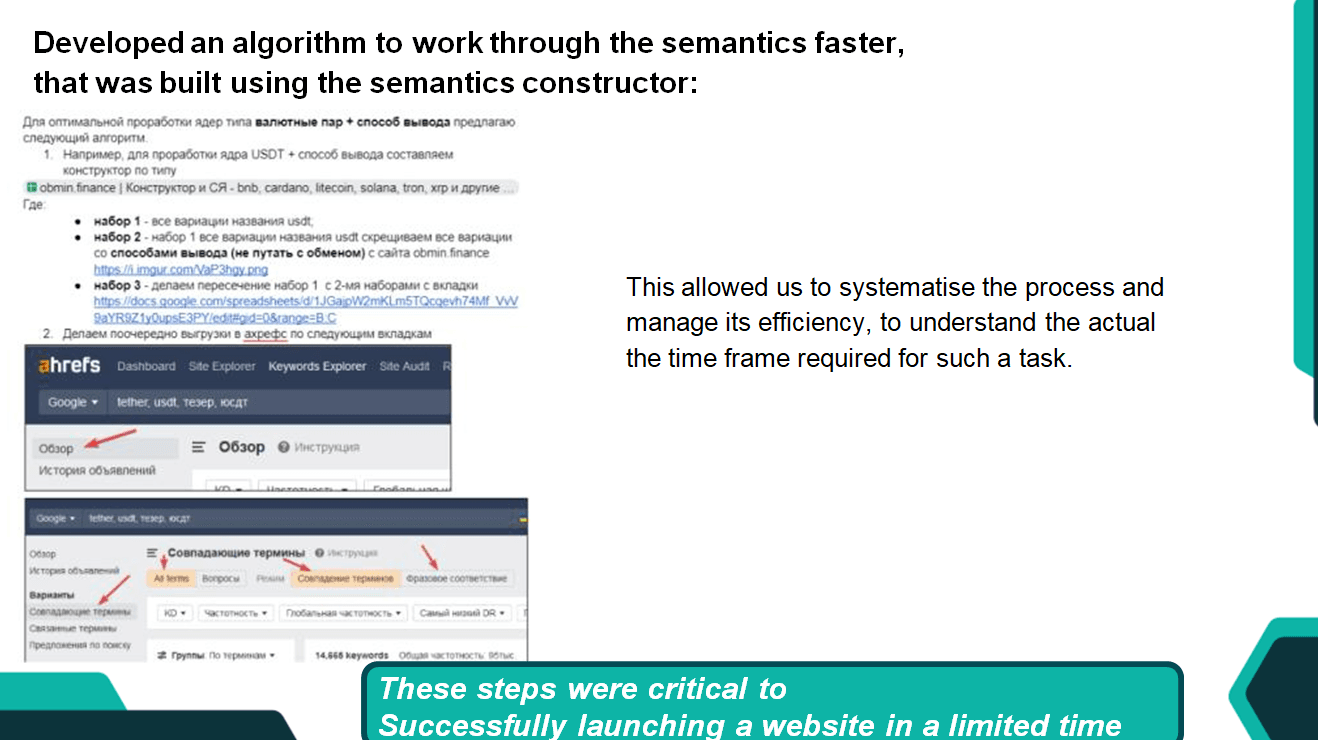

Working with such a huge volume of search queries required a combined approach: maximum automation of processes using specialized tools (collection, cleaning, initial clustering) + thorough expert review and refinement (because no algorithm has yet learned to perfectly understand all the nuances of human speech and intent).
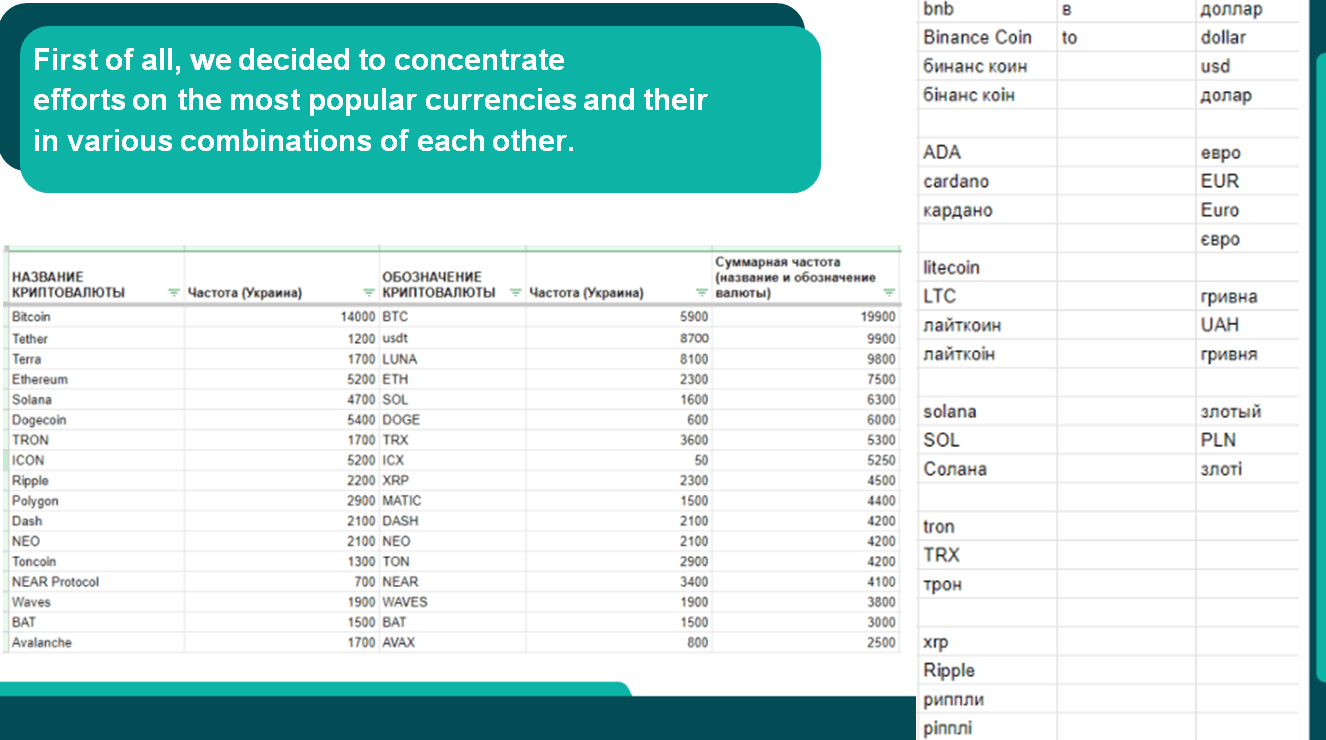

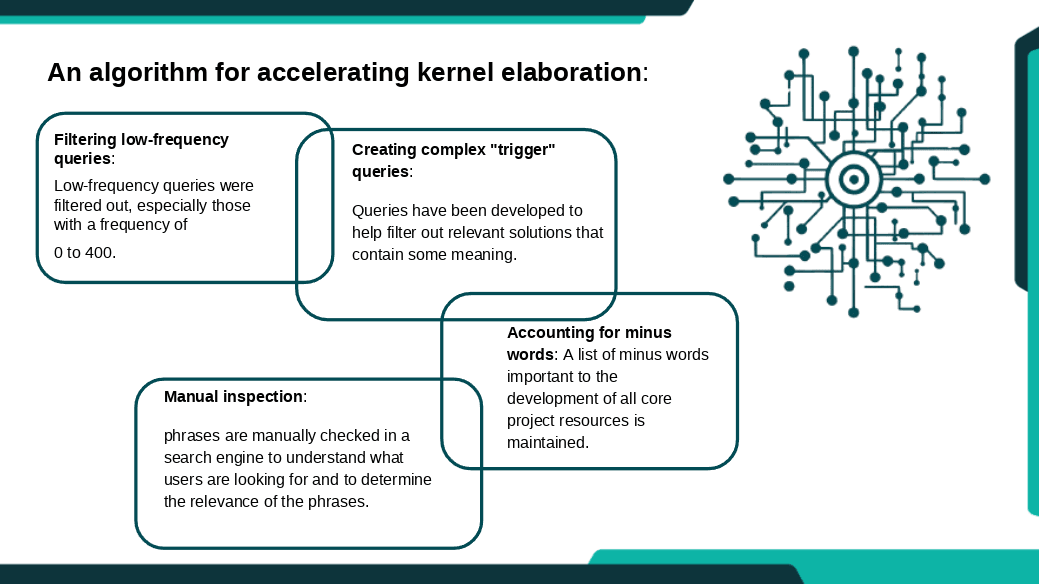

Classification by intent – we divided all requests into main groups:
Commercial (transactional): a clear desire to make an exchange (“buy Bitcoin for hryvnia”, “exchange Privat24 for USDT”, “put Ethereum on a card”). These are the most valuable requests for an aggregator.
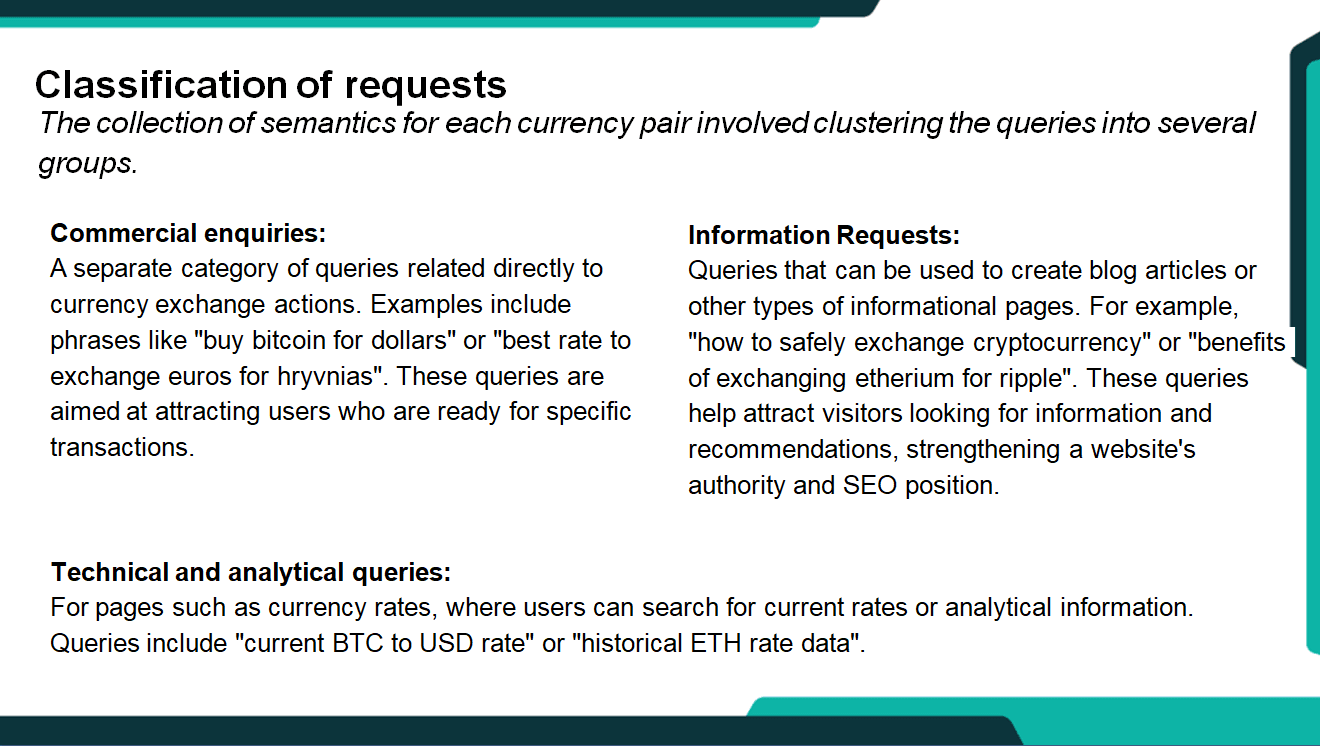

Informational: searching for information (“what is TRC20”, “what is the current Ethereum to UAH exchange rate”, “how to use exchangers safely”). Such queries drive traffic to the blog and build expertise.
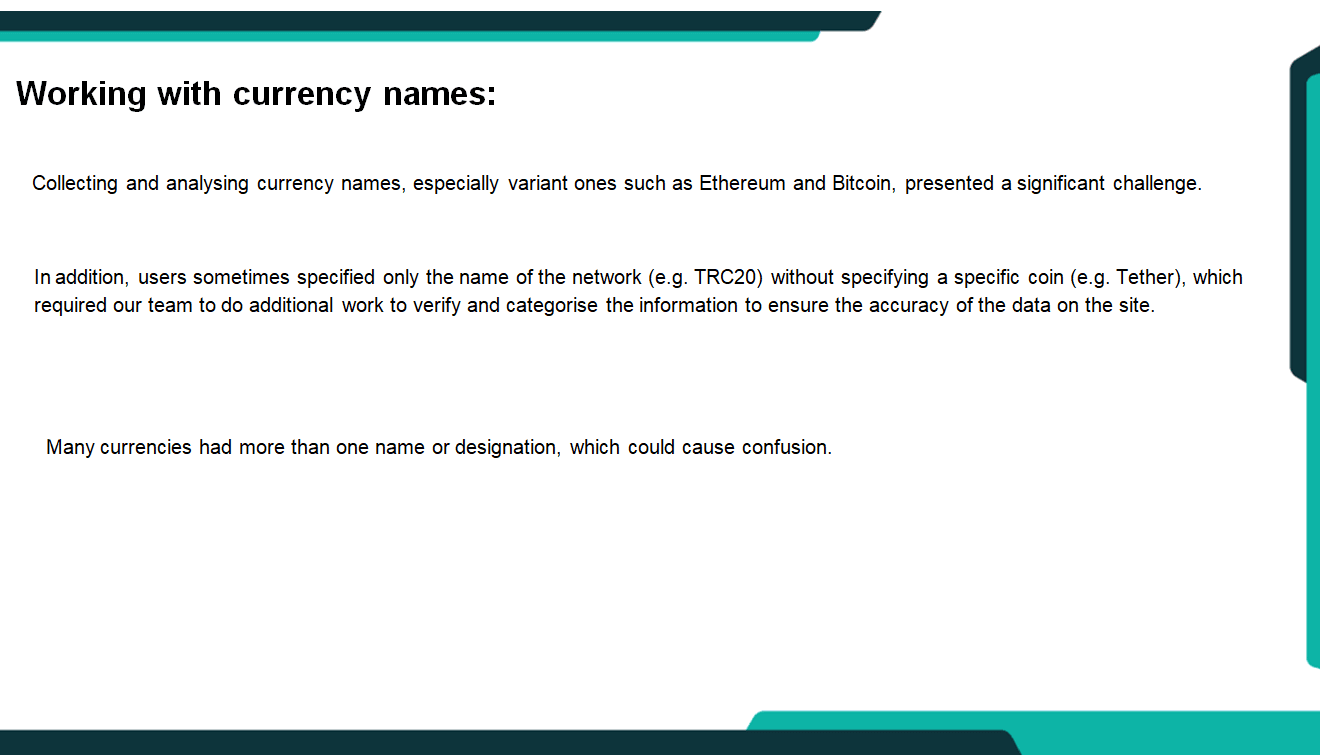

Analytical (navigational/comparative): searching for the best conditions or a specific service (“where is the most profitable online currency exchange”, “crypto exchangers rating 2024”, “reviews of Obmin.Finance”).
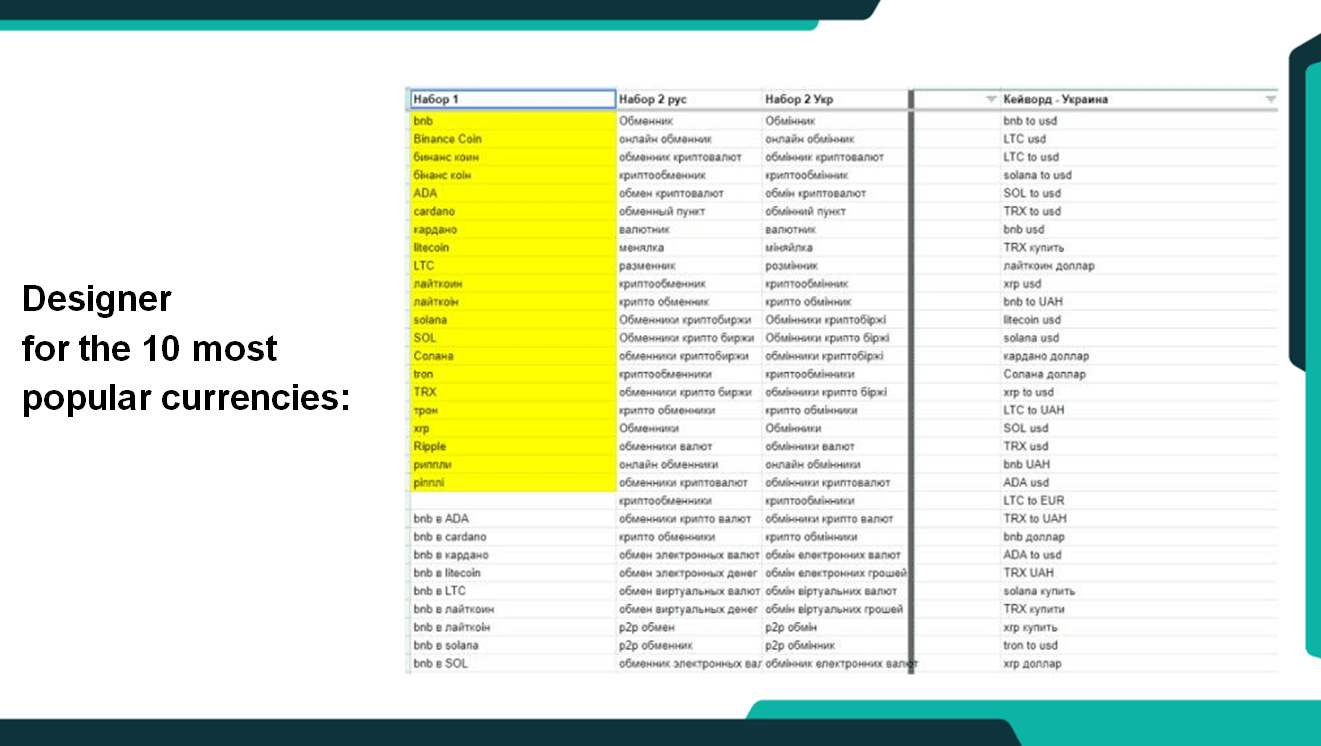

Puzzle qu eries: how to classify a query of the “TRC20 + Monobank” type? The user does not specify a specific currency. We developed and implemented a heuristic algorithm (and logic for editors) that, based on the context (TRC20 is a Tron network, Monobank is a popular bank for USDT transactions), determined with a high probability that it was a query about exchanging USDT in the TRC20 network for hryvnia through Monobank. Almost Sherlock Holmes in the world of SEO.


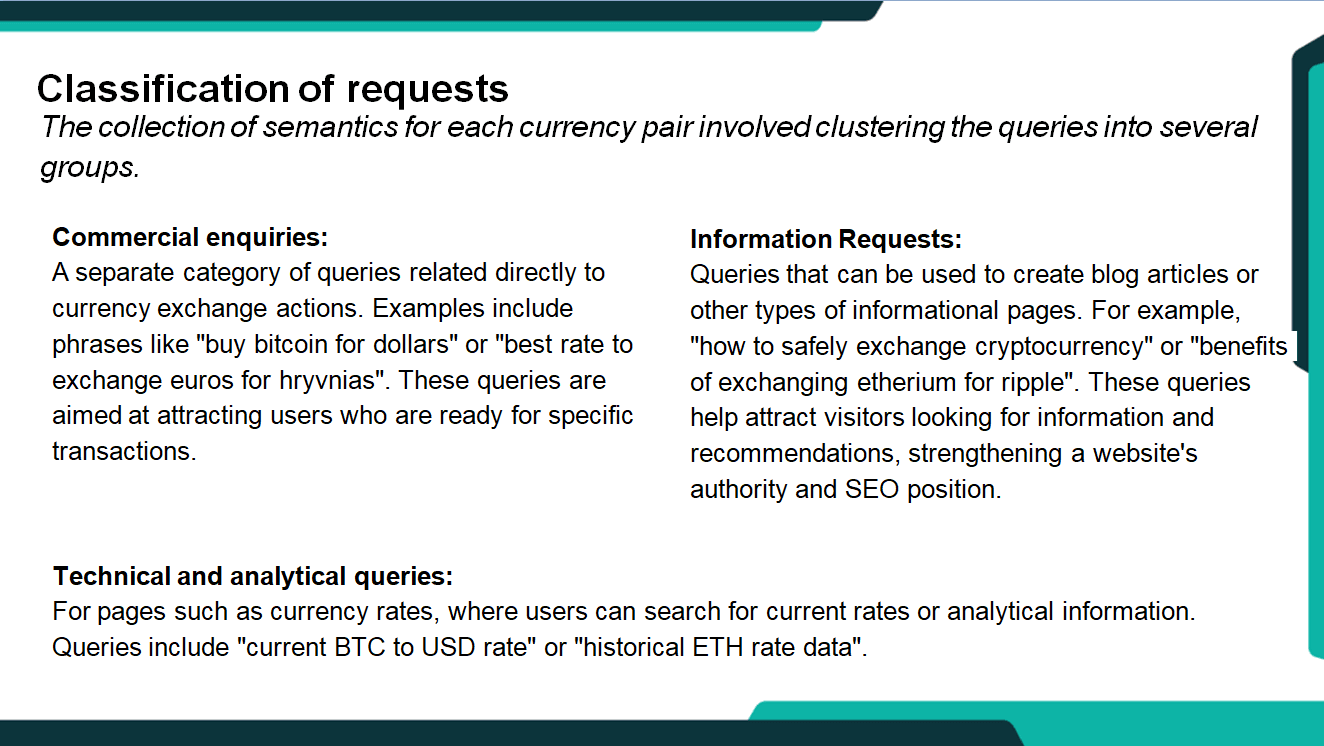

The home page is not a static showcase, but a dynamic hub with the most popular exchange destinations, current rates, and possibly market news.
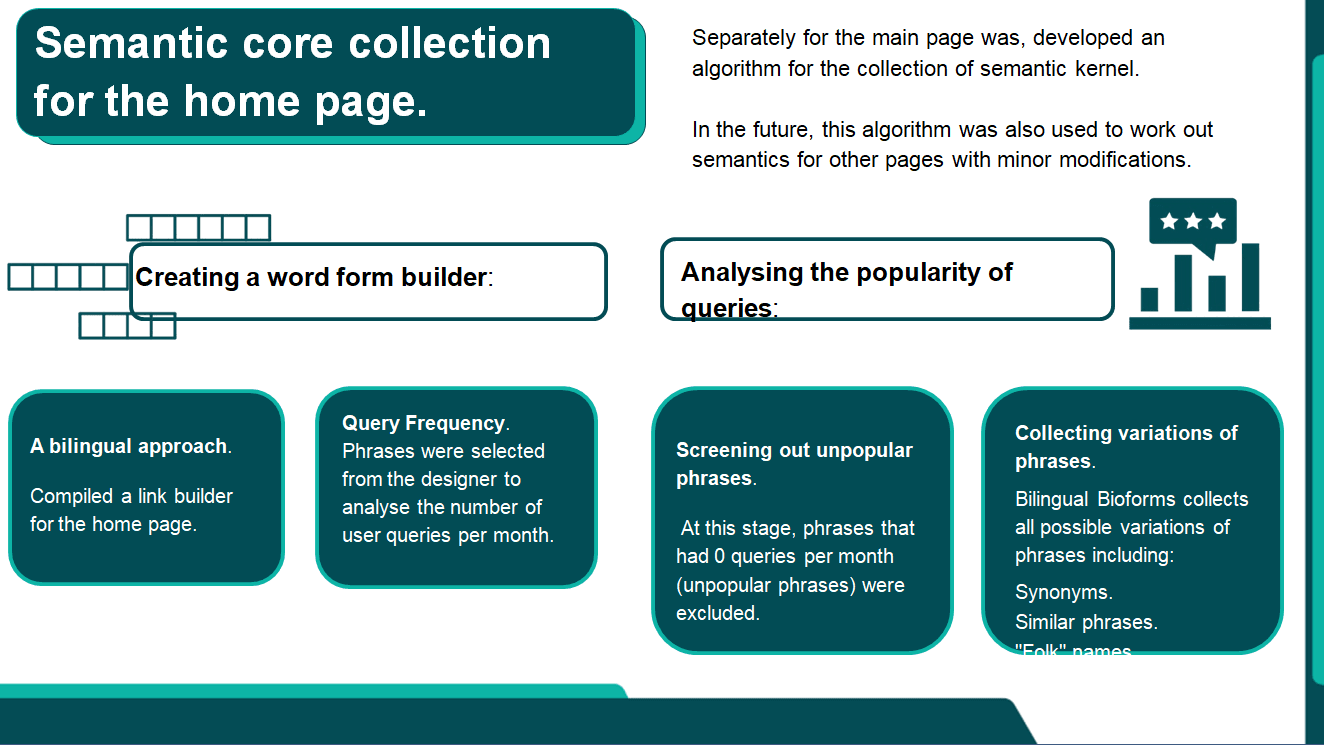

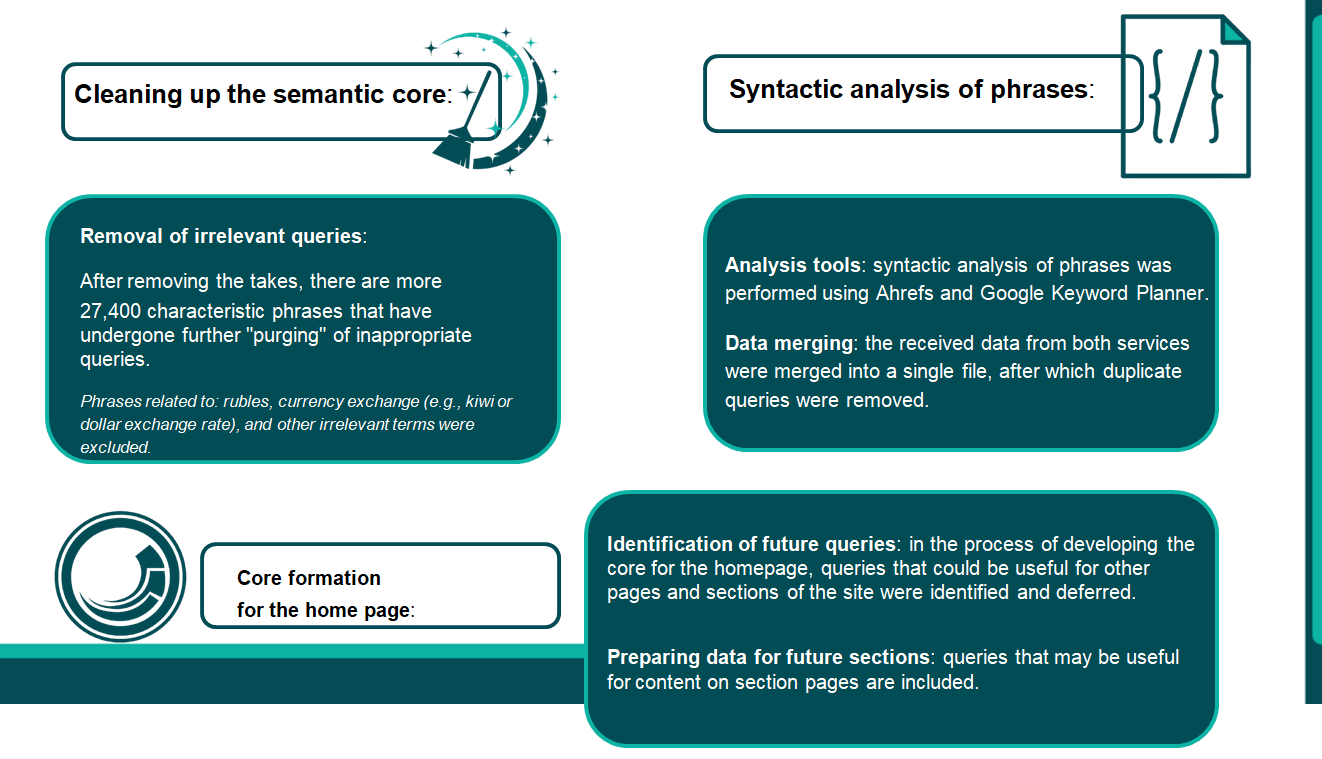

Category pages: a clear and logical hierarchy: separate sections for cryptocurrency exchange, fiat currencies, transactions between different payment systems, and possibly analytical tools.
Currency pairs pages: thousands of template pages, but unique due to meta tags and content for each specific pair (for example, “Bitcoin (BTC) to Privat24 UAH exchange”). Always with automatic updates of rates from partners.


In such a competitive and specific niche as finance and cryptocurrencies, content performs several key functions: it attracts traffic based on information requests, educates users, builds trust, and demonstrates the platform’s expertise. We have divided content into two main types:
Pages for exchange partners: clearly, understandably, and convincingly explain the benefits of cooperation with Obmin.Finance, the terms of connection, and technical requirements.
Promotional materials: blocks on the website that call on exchangers to join the monitoring (“Want more customers? Join us!”).
Service pages: a detailed description of how the platform works for the end user.
Guides and instructions: step-by-step guides for beginners and beyond (“How to choose a reliable online exchange and avoid fraudsters?”, “What is KYC/AML and why do exchangers need it?”, “How to store cryptocurrency safely?”).
Analytics and market news: trend reviews, explanations of important events (“Why did Luna fall and what does it mean for the market?”, “Prospects for crypto regulation in Ukraine”).
Glossary of terms: explaining complex concepts in simple terms.
We found that the query “What is monitoring exchangers?” has good potential, but competitors disclose it rather superficially. We prepared an extensive, detailed guide explaining how such services work, their advantages and disadvantages, with examples and tips.


The result (expected): such a page will attract targeted traffic not only for the main keyword, but also for dozens of related low-frequency queries (the so-called “long tail”), for example: “how does an exchange rate aggregator work”, “is it safe to use monitoring exchangers”, “who checks exchangers”. In total, there are potentially 30+ relevant keys leading to one high-quality article. This is not only traffic, but also a demonstration of expertise.
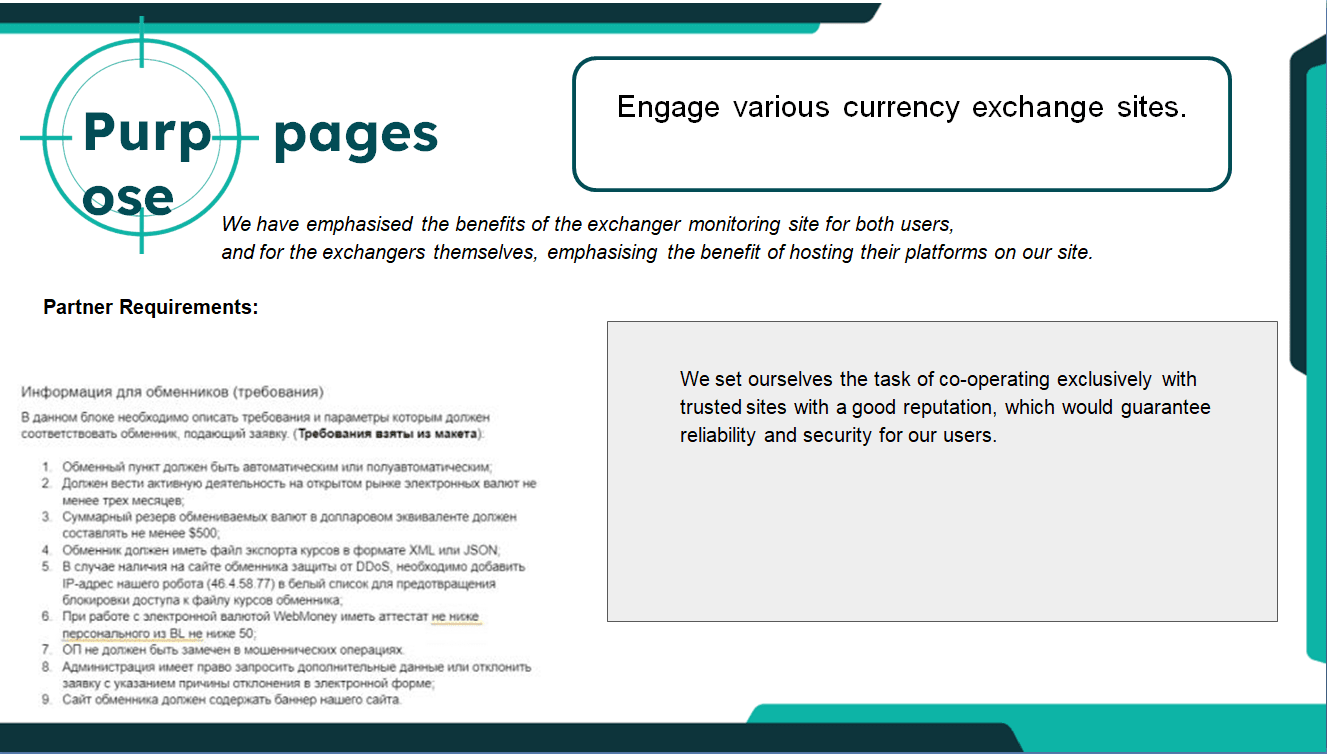

Attracting reliable partner exchanges is a key success factor for an aggregator. To make this process effective, we developed a special promotional page (landing page) that performed several tasks:
Demonstration of benefits: clearly showed what the exchanger would get from cooperation: access to the target audience (new customers), increased exchange volumes, and an additional promotion channel.
Transparent conditions. Describes the requirements for partners: availability of appropriate licenses (if required by law), proven experience in the market (for example, at least 6 months), positive reputation, and sufficient reserves. This is important for filtering out unreliable players and protecting Obmin.Finance end users.
Convenient connection process: providing clear instructions for technical integration (API for course transfer).
Integration with the CRM system: the partnership application form was directly connected to the client’s CRM. This made it possible to automatically register leads, distribute them among managers, and track the status of negotiations without losing any potential deals.
The landing page feature: an interactive banner or a small calculator of potential benefits. The exchanger could enter approximate data on their volumes or average check, and the calculator would show the estimated additional income or number of customers they could get thanks to placement on Obmin.Finance. A simple but effective way to visualize the benefits.
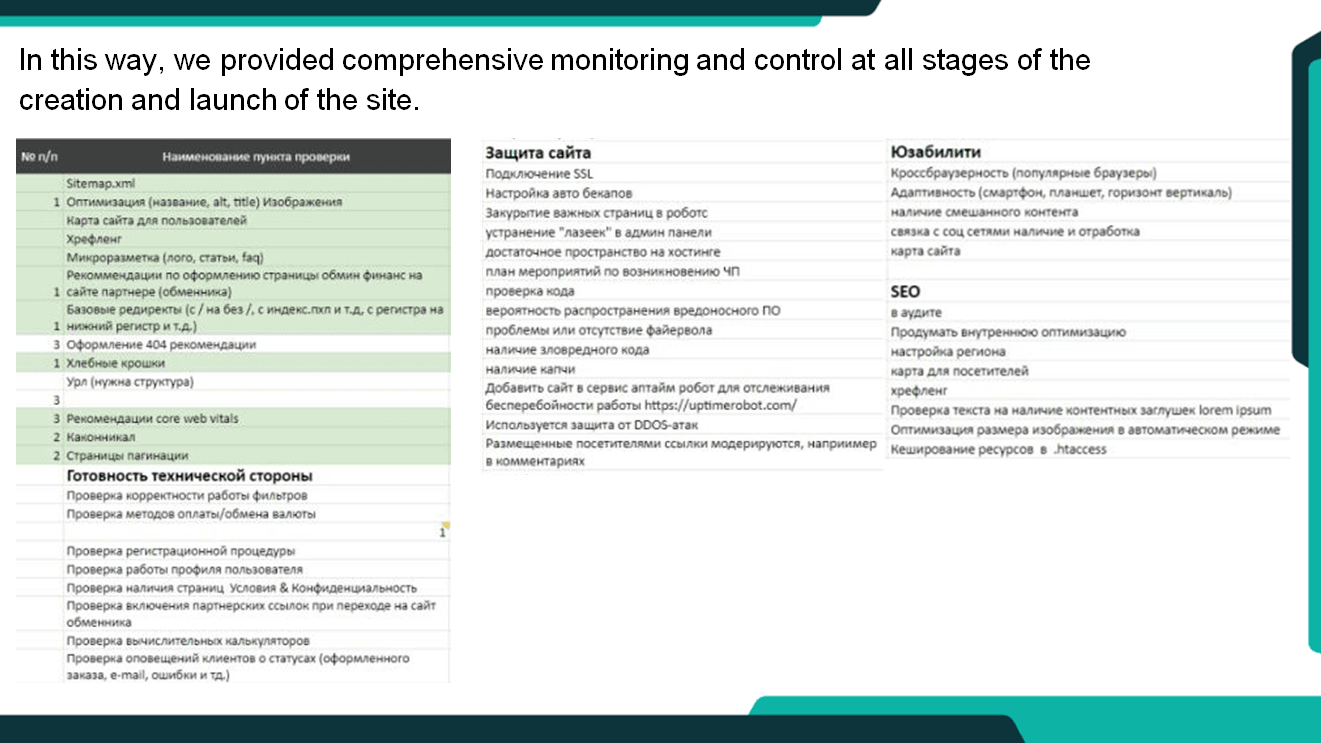



4. A clear understanding of the competitive environment: the analysis of the top 10 players, especially BestChange, allowed us to identify their weaknesses and formulate a strategy for how Obmin.Finance can undercut them and gain market share.
Why was all this preparation critical (besides the fact that it was our job)?
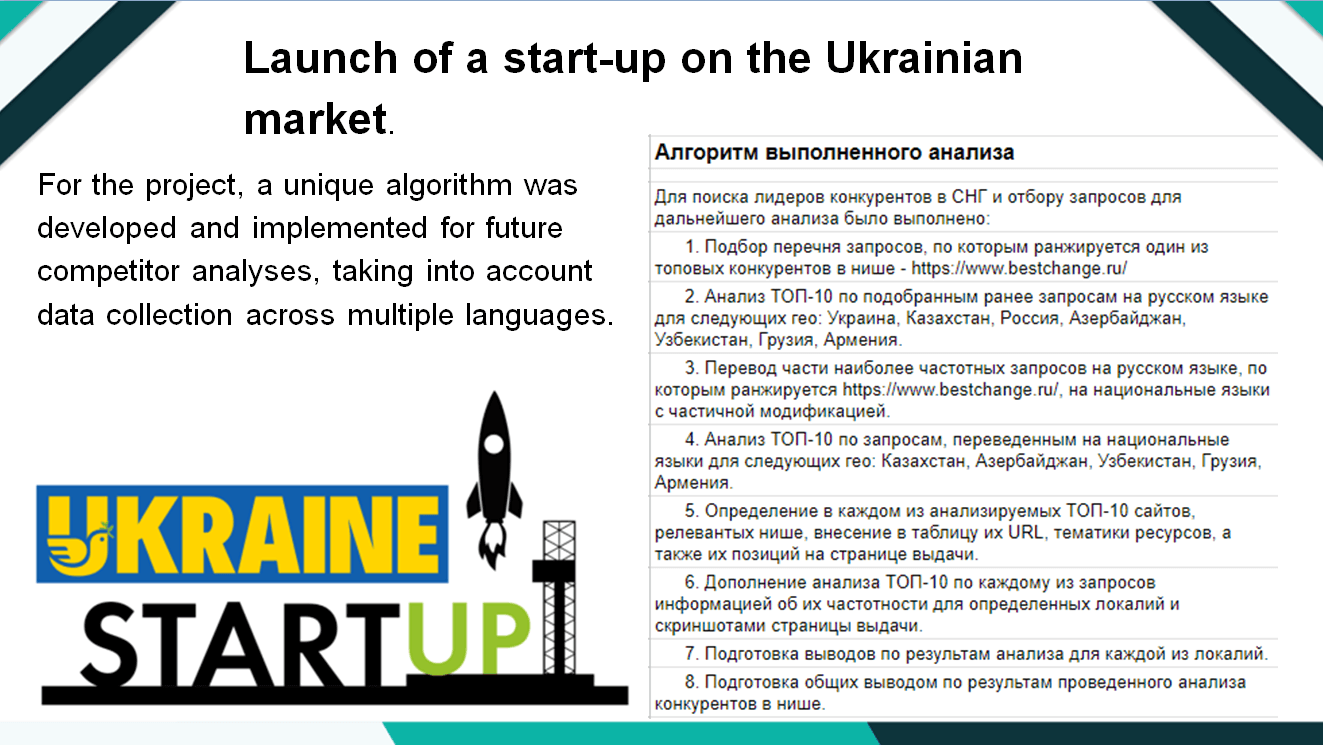

Decisive first months: the first 3 months after the launch of a new website are extremely important for its future fate in search engines. Google takes a close look at newcomers. Our work allowed us to avoid many of the typical problems that hinder the development of many young projects and start gaining visibility much faster. It’s like starting a race from the pole, not from the last row or the pit lane after a penalty. It saves the team time, money, and nerves in the future.
It was not a job, but a real space odyssey, where the office turned into a starship bridge, and Jira became the very Control Center that kept us from getting completely lost in the outer space of tasks. Our SEO specialists are bearded geniuses who patch holes with the power of thought (and coffee). Our copywriters were linguistic wizards who composed spells of texts that even space pirates could understand. Programmers are the creators of interfaces that Steve Jobs himself would ask for an autograph (well, maybe). And the client, our brave Captain, set the vector of movement to new stars of success. And even though the asteroid field of deadlines was trying to turn our ship into scrap, Jira, like a faithful R2-D2, winked at us with its lights: “Relax, Master, all systems GO! We’ll show this universe!
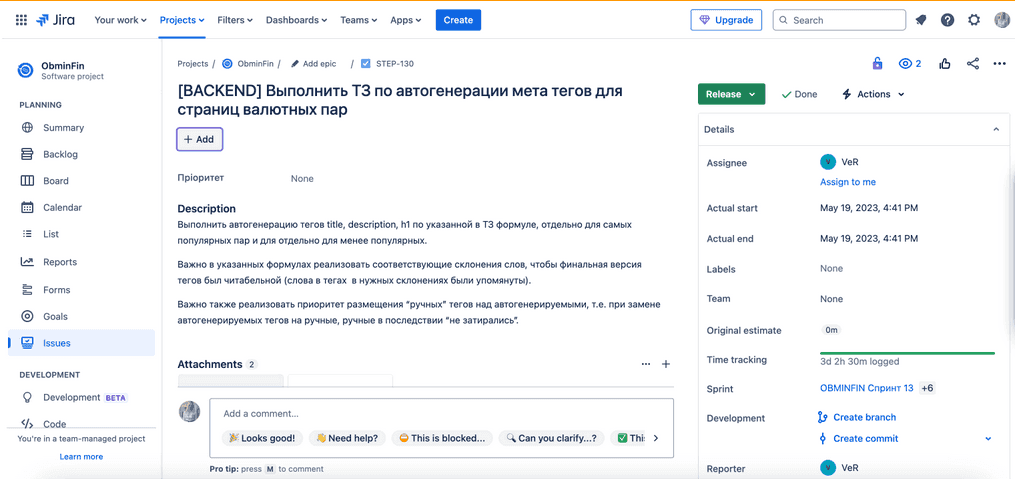

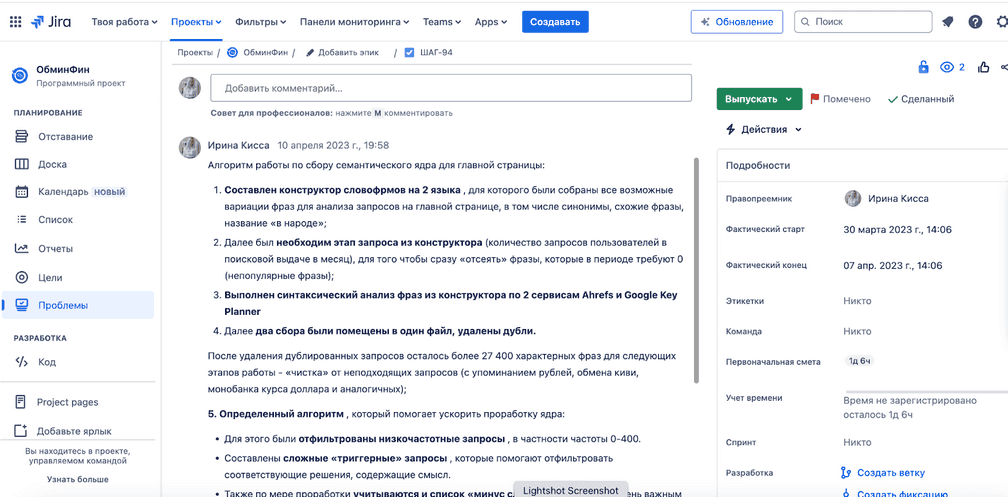

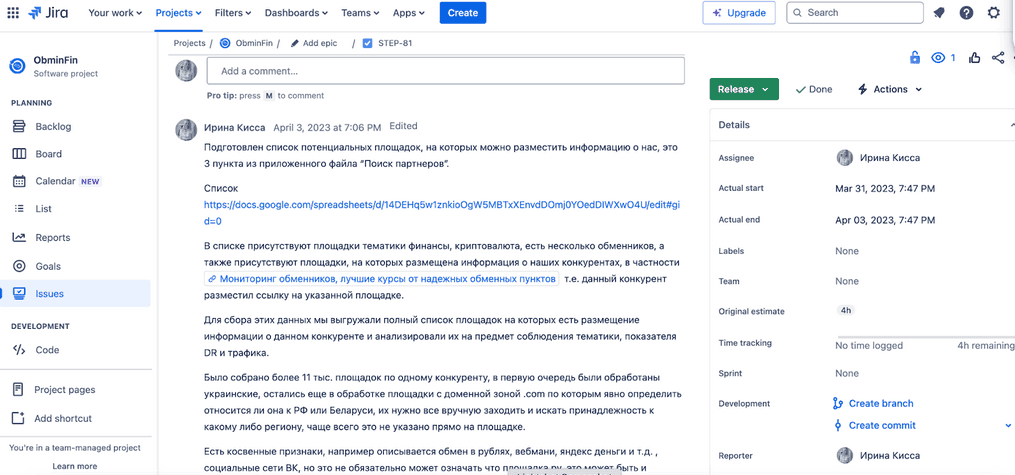

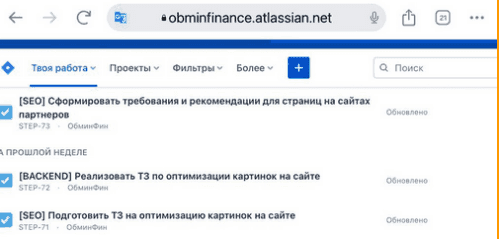

Controlled launch of indexing: final check of all the items on our checklist before opening the site for search robots.
Continuous monitoring of positions: regular tracking of positions for key queries (especially the top 10 commercial keys) in all 7 target countries.
Iterative content expansion: gradually adding new articles to the blog, expanding the semantics, and preparing and launching new language versions, in particular for the markets of Georgia and Armenia, where competition was lower.
Analytics and adjustments: analyzing user behavior, the effectiveness of various traffic channels, and continuously improving the site based on the data obtained.
Conclusion (without unnecessary pathos): JobStudio did more than just a set of standard SEO tasks. We actually co-authored the product’s architecture and strategy at an early stage. We have built a system that gives Obmin.Finance not just a chance, but a real, reasonable opportunity to compete for leadership in a very complex and competitive market of financial aggregators in Ukraine and the CIS. Only time, the market, and the efforts of their own team will tell whether they will be able to fully realize this potential. But the start has been made strong.